
Volume 25 Number 3 - March 2025






Volume 25 Number 3 - March 2025




03. Editor's comment
05. Pipeline news
Contract news and updates from Saipem, Eni, Penspen and more.
KEYNOTE: HYDROGEN PIPELINE TRANSPORT
08. From science fiction to reality
World Pipelines Contributing Editor, Gordon Cope, studies the future of the global midstream hydrogen economy.

15. Hydrogen's tipping point
Kimberly Sari, ILF Consulting Engineers.
19. Verifying the hydrogen flow of the future Niamh Rogers, Lucie Dangeon-Vassal, and Rémy Maury, Cesame-Exadebit.
CONSTRUCTION
25. A progressive approach to pipeline welding Jason Blubaugh, Miller Electric Mfg. Co.

FLOW
31. Ensuring flow assurance in a changing environment Jim Bramlett, Tracerco.
COATINGS AND CORROSION
33. CUI management: manual vs predictive inspection Dr Prafull Sharma, CorrosionRADAR.
ENVIRONMENT
37. Robust solutions for the new energy sector Nora Brahmi and Corinne Willecombe, Vallourec.
HEAVY EQUIPMENT
42. Superior protection, faster installation Meghan Connors, PipeSak.

51. Maximising productivity with maxi rig maintenance
Kelly Beller, Vermeer Corporation.
SYSTEMS AND SOFTWARE
55. A new dawn for GIS and pipeline integrity management
Michael Ray and John Minassian, Emerson.
AWARD WINNERS: YPI
61. Recognising young achievement
Zachary Booth, DNV, and Kaushal Shah, ICF.
Ultimate Surface Preparation – Made in Germany. The world’s only hand tools that can “sandblast”. The patented Bristle Blaster® Technology removes corrosion and coatings quickly and thoroughly. At the same time, the Bristle Blaster® creates surface preparation grades comparable with Sa2½ (SSPC-SP 10/NACE No. 2) to Sa3 (SSPC-SP 5/NACE No. 1) and roughness levels of up to 120 μm Rz. Consequently, surfaces that have been treated by the Bristle Blasting tool have a
and visual cleanliness that mimics those



MANAGING EDITOR
James Little
james.little@worldpipelines.com
EDITORIAL ASSISTANT
Alfred Hamer alfred.hamer@worldpipelines.com
SALES DIRECTOR
Rod Hardy rod.hardy@worldpipelines.com
SALES MANAGER
Chris Lethbridge chris.lethbridge@worldpipelines.com
SALES EXECUTIVE
Daniel Farr daniel.farr@worldpipelines.com
PRODUCTION DESIGNER
Amy Babington amy.babington@worldpipelines.com
HEAD OF EVENTS
Louise Cameron
louise.cameron@worldpipelines.com
DIGITAL EVENTS COORDINATOR
Merili Jurivete merili.jurivete@worldpipelines.com
EVENTS COORDINATOR
Chloe Lelliott chloe.lelliott@worldpipelines.com
DIGITAL CONTENT COORDINATOR
Kristian Ilasko kristian.ilasko@worldpipelines.com
JUNIOR VIDEO ASSISTANT
Amélie Meury-Cashman amelie.meury-cashman@worldpipelines.com
DIGITAL ADMINISTRATOR
Nicole Harman-Smith nicole.harman-smith@worldpipelines.com
ADMINISTRATION MANAGER
Laura White laura.white@worldpipelines.com
Palladian Publications Ltd, 15 South Street, Farnham, Surrey, GU9 7QU, UK Tel: +44 (0) 1252 718 999 Website: www.worldpipelines.com Email: enquiries@worldpipelines.com
Annual subscription £60 UK including postage/£75 overseas (postage airmail). Special two year discounted rate: £96 UK including postage/£120 overseas (postage airmail). Claims for non receipt of issues must be made within three months of publication of the issue or they will not be honoured without charge.
Applicable only to USA & Canada: World Pipelines (ISSN No: 1472-7390, USPS No: 020-988) is published monthly by Palladian Publications Ltd, GBR and distributed in the USA by Asendia USA, 701C Ashland Avenue, Folcroft, PA 19032. Periodicals postage paid at Philadelphia, PA & additional mailing offices. POSTMASTER: send address changes to World Pipelines, 701C Ashland Avenue, Folcroft, PA 19032.

In a few ways, the pipeline industry is currently revisiting the past.
Texas-based Energy Transfer’s lawsuit against Greenpeace has made it to the courts in North Dakota. The trial, which is expected to last into April, sees Energy Transfer allege that protest tactics by the environmental organisation delayed the Dakota Access Pipeline project.
The lawsuit accuses Greenpeace of an “unlawful and violent scheme to cause financial harm to Energy Transfer, physical harm to its employees and infrastructure, and to disrupt and prevent Energy Transfer’s construction of the Dakota Access Pipeline”.
Greenpeace says it did not lead the protests, which took place near the Standing Rock Sioux Reservation, saying that it instead helped support “nonviolent, direct-action training” on safety and de-escalation on-site.
You’ll recall that the protests drew crowds of over 10 000 to the encampment, as they attempted to block the path of the pipeline from crossing the Missouri River, upstream from Standing Rock. The protests started in April 2016 and ended in February 2017 when the National Guard and police cleared the site.
Energy Transfer brought a similar federal lawsuit in 2017, arguing that protesters had violated the Racketeer Influenced and Corrupt Organisations Act (Rico), which is an allegation commonly made against organised crime groups. A judge dismissed the case.
The new state trial is taking place in conservative North Dakota. If it is found that Greenpeace tried to delay construction of the pipeline, defamed the companies behind it, and coordinated trespassing, vandalism and violence by pipeline protesters, then damages could run to US$300 million. Greenpeace says it would “face financial ruin, ending over 50 years of environmental activism”.
In another blast from the past, President Trump has declared that he wants the Keystone XL pipeline built, pledging easy regulatory approvals for the previously cancelled project. The permit for KXL was revoked by the Biden administration in 2021, following years of opposition and delays under Obama (who rejected it in 2015).
The multi-billion dollar, 1200 mile pipeline project was designed to bring oilsands from western Canada to US refiners and was owned by TC Energy Corp.
South Bow Corp., the oil pipeline business that spun off from TC Energy Corp., has indicated that it is not interested in a revival of the project. Parts of the system, which runs through Alberta, Montana, South Dakota and Nebraska, have already been dismantled, and key permits have long since expired.
“If not them, perhaps another pipeline company,” Trump said in a post on his social media network. “We want the Keystone XL Pipeline built!”
Back to 2025 and the challenges of getting new pipeline infrastructure in the ground still remain: in the keynote article for this issue, our correspondent Gordon Cope writes about how the building of hydrogen pipeline transport has gone “from science fiction to reality” (p.8). ILF writes about the specific regulatory, financial, stakeholder and supply chain hurdles that are bottlenecking hydrogen pipeline projects in Europe (p.15). PipeSak describes working with several pipeline operators (TC Energy, Williams, Enbridge) on protecting pipe coatings during construction (p.42). And I speak to the two winners of the PPIM 2025 YPI Award for Young Achievement about what it’s like to be a young pipeliner in 2025, and how the future looks to this new generation of pipeline workers.



Global oil and gas contract value remains stable in 4Q24: GlobalData
The global oil and gas industry experienced a 15% quarter-onquarter decrease in the total number of contracts, from 1596 in 3Q24 to 1353 in 4Q24. Despite the dip in volume, the overall contract value remained stable, driven by the announcement of some major contracts in Africa, reveals GlobalData.
GlobalData’s latest report, ‘Oil and Gas Industry Contracts Review by Sector, Region, Terrain and Top Contractors and Issuers, Q4 2024,’ reveals that the overall contract value remained relatively stable at US$39.2 billion in 4Q24 compared to US$38.8 billion in 3Q24.
The major contracts announced in the African region include Tecnicas Reunidas and Sinopec Engineering’s US$4 billion new deep conversion oil refinery project in Algeria’s Hassi Messaoud region, and US$1.4 billion Wuhuan Engineering and WeDo’s ammonia and urea plant project in Angola.
Pritam Kad, Oil and Gas Analyst at GlobalData, comments: “Sinopec Engineering replacing Samsung Engineering to partner with Tecnicas Reunidas for the 5 million tpa deep conversion refinery project in the Hassi Messaoud region of Algeria was a
significant value booster, along with the support from JGC Indonesia US$2.4 billion compression contract for the Tangguh LNG contract, Saipem’s US$1.9 billion GranMorgu subsea development contract in Suriname, and Wuhuan Engineering and WeDo’s contract for an ammonia and urea plant in Angola. These contracts were crucial in keeping the contract value stable despite the decline in volume.”
Operation and maintenance (O&M) represented 50% of the total contracts in 4Q24, followed by procurement scope with 30%, and contracts with multiple scopes, such as construction, design and engineering, installation, O&M, and procurement, which accounted for 10%.
Some other notable contracts during the quarter were Bram Offshore and Starnav Servicos Maritimos’ US$2.74 billion construction and charter contract from Petrobras for 12 Platform Supply Vessels (PSVs) and Saipem’s US$1.9 billion contract from TotalEnergies EP Suriname for the EPC, supply, pre-commissioning, and commissioning assistance for the subsea umbilicals, risers, and flowlines (SURF) package for the GranMorgu project in Suriname.
Saipem announces agreement in principle for merger with Subsea7 Saipem and Subsea7 have announced that they have reached an agreement in principle on the key terms of a possible merger of the two companies through the execution of a Memorandum of Understanding (MoU). The proposed combination is expected to create a global leader in energy services.
The combination of Saipem and Subsea7 will be renamed Saipem7, and will have a combined backlog of €43 billion, revenue of approximately €20 billion and EBITDA in excess of €2 billion.
The merger would create a global organisation of over 45 000 people, including more than 9000 engineers and project managers. Saipem and Subsea7 shareholders will own 50% each of the share capital of the combined company. Subsea7 shareholders will receive 6.688 Saipem shares for
each Subsea7 share held. Subsea7 will distribute an extraordinary dividend for an amount equal to €450 million immediately prior to completion.
The transaction is expected to deliver material value creation for the shareholders of both Saipem and Subsea7. Annual synergies of approximately €300 million are expected to be achieved in the third year after completion, with oneoff costs to achieve such synergies of approximately €270 million.
The combined company will be listed on both the Milan and Oslo stock exchange. Siem Industries, reference shareholder of Subsea7, as well as Eni and CDP Equity, reference shareholders of Saipem, have expressed their strong support and intend to vote in favour of the transaction.
Completion is anticipated to occur in 2H26.
Kazakhstan’s primary oil export route, managed by the Caspian Pipeline Consortium (CPC), was disrupted due to a drone strike on 17 February at the Kropotkinskaya pumping station. Situated in the Kavkazsky district of Kuban, the station is the largest CPC pump station in Russian territory, CPC said.
The attack, involving seven drones, has been labelled as an act of terrorism by the consortium.
While the CPC did not directly attribute the incident to Ukraine, an official from Ukraine’s SBU security service claimed responsibility for the attack, stating that it targeted the pumping station and the nearby Ilsky oil refinery, reported Reuters.
The strike occurred a day before US Secretary of State
Marco Rubio met Russian Foreign Minister Sergei Lavrov in Saudi Arabia for Ukraine war talks.
In a statement, CPC said that, as a result of the strike, the Kropotkinskaya pumping station “has been taken out of service. Crude transportation through Tengiz-Novorossiysk pipeline system is being maintained at reduced flowrates.”
The CPC pipeline is a key channel for global oil supply, with Kazakhstan contributing approximately 1% of the world’s oil.
The Tengiz-Novorossiysk pipeline spans 1511 km, carrying more than two-thirds of Kazakhstan’s oil exports along with crude from Russian oilfields, including those in the Caspian region. Other shareholders in the CPC include Shell, Italy’s Eni and the Russian state.
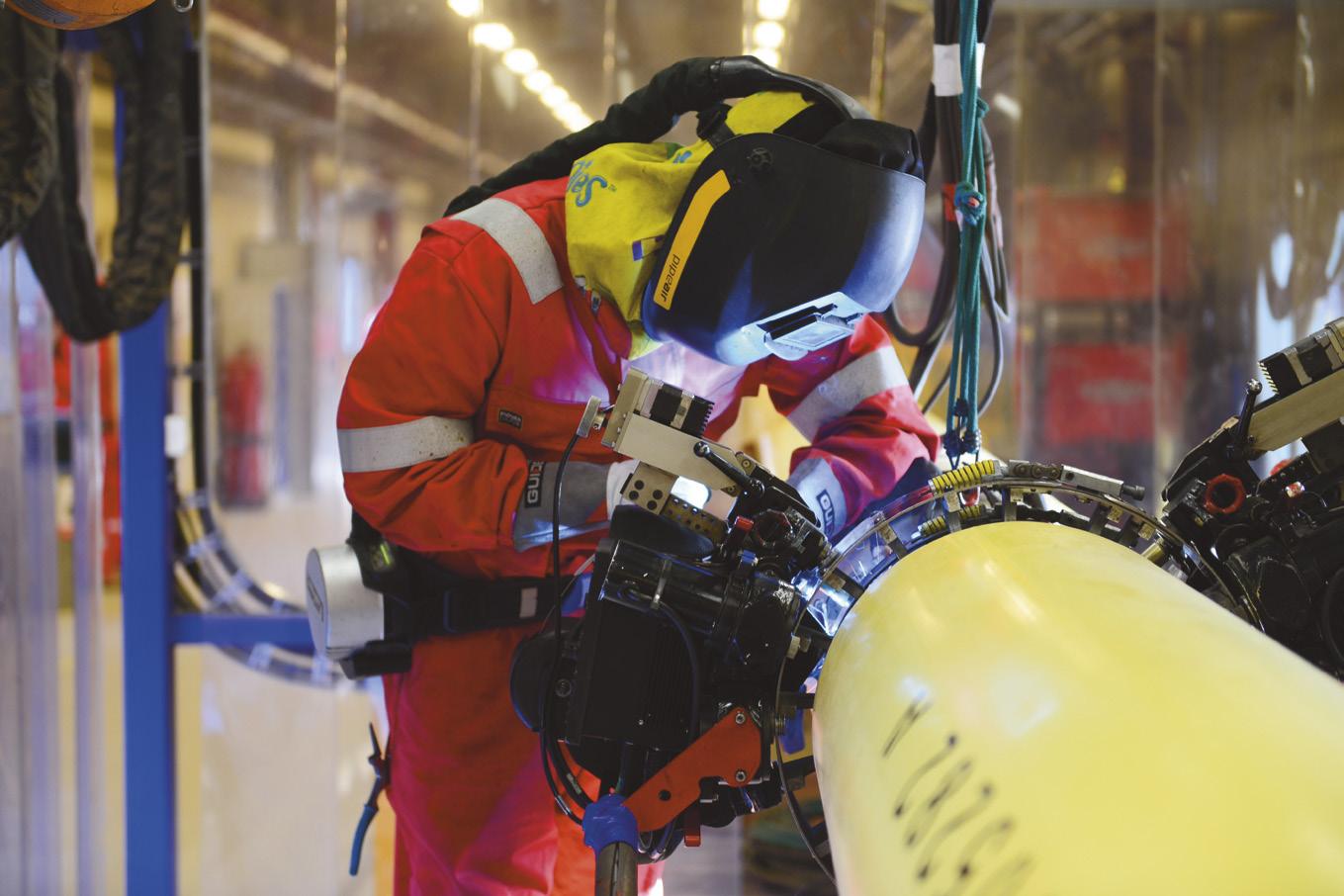
6 - 10 April 2025
AMPP 2025
Nashville, USA
https://ace.ampp.org/home
5 - 8 May 2025
6 gas
20th Pipeline Technology Conference Berlin, Germany
https://www.pipeline-conference.com/
5 - 8 May 2025
Offshore Technology Conference 2025 Houston, USA
https://2025.otcnet.org/
19 - 23 May 2025
29th World Gas Conference (WGC2025)
Beijing, China
https://www.wgc2025.com/eng/home
25 - 29 May 2025
Annual Pipe Line Contractors Association of Canada (PLCAC) Convention
Banff, Canada
https://pipeline.ca/
10 - 12 June 2025
Global Energy Show 2025 Calgary, Canada
https://www.globalenergyshow.com/
25 - 26 June 2025
Carbon Capture Technology Expo North America 2025 Houston, USA
https://www.ccus-expo.com/about/registrationnorth-america
9 - 12 September 2025
Gastech Exhibition & Conference
Milan, Italy
https://www.gastechevent.com/visit/visitorregistration/
On 17 February, the Minister of Petroleum and Mineral Resources of the Arab Republic of Egypt Karim Badawi, the Minister of Energy, Commerce and Industry of the Republic of Cyprus George Papanastasiou, the Chief Executive Officer of Eni Claudio Descalzi, as well as TotalEnergies; signed in Cairo the Host Government Agreement for the exploitation of Cyprus’ Cronos Block 6 resources.
This agreement is a step on the way to establishing a gas hub in the Eastern Mediterranean capitalising Egypt’s existing hydrocarbon infrastructure and positioning Cyprus as a gas producer and exporter. It outlines a comprehensive framework enabling a rapid development of the Cronos gas discovery offshore Cyprus: the gas will be transported and processed in existing Zohr facilities to be then liquefied in the Damietta
Penspen announces US$120 million new contract awards
Penspen has announced US$120 million awarded in new contracts during 2H24, a 14% increase on the same period in 2023, taking total 2024 sales to over US$225 million.
Middle East and Africa Region represents 26 new contracts with a total value of US$98 million including study, FEED, detailed design, integrity assessment, fitness-for-service (FFS) assessment, project management supervision and consultancy services.
The Kingdom of Saudi Arabia Region has two new renewable energy-focused framework agreements covering the provision of study, FEED, detailed design and project management supervision services for hydrogen production, wind and geothermal energy supply.
In the UK and Europe region, Penspen reports 57 new contracts with a total value of US$16 million including fuelling terminal operations, pipeline maintenance and inspection, hydrogen repurposing, hydrogen blending, carbon capture studies, gas compression upgrades, and pipeline diversions.
In North America and Latin America, there were 18 new contracts with a total value of US$5 million including projects for pipeline fitness for service, electrical interference and cathodic protection studies, gas pipeline project management, production operations support, and environmental testing.
LNG plant for export to European markets. Eni CEO, Claudio Descalzi, commented: “This agreement paves the way to bring Cyprus’ gas to the market in a timely fashion, contributing to energy security and competitiveness of energy supply. This project leverages Egypt’s existing infrastructure, including export facilities, which are a key enabler for developments in the Region. Egypt and Cyprus reaffirm their roles in the emerging energy hub of the Eastern Mediterranean, which is set to play an increasing role in the global gas supply in the near future”.
Discovered in 2022 and subsequently appraised in 2024, Cronos gas in place is estimated at more than 3 trillion ft3 Additionally, Block 6 encompasses further potential resources under exploration and appraisal.
• US approves LNG exports, forms energy council to boost oil and gas
• Energy Transfer and CloudBurst sign agreement for natural gas supply to data centre project in Central Texas
• Five countries sign joint declaration of intent to continue work on southern hydrogen corridor
• ECITB Census reveals challenges facing oil and gas
• Howard Energy Partners acquires operating interest in Midship Pipeline
Follow us on LinkedIn to read more about the articles linkedin.com/showcase/worldpipelines




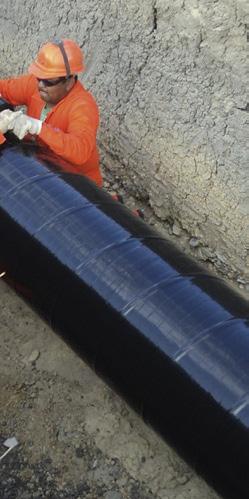

PROTECTIVE OUTERWRAPS

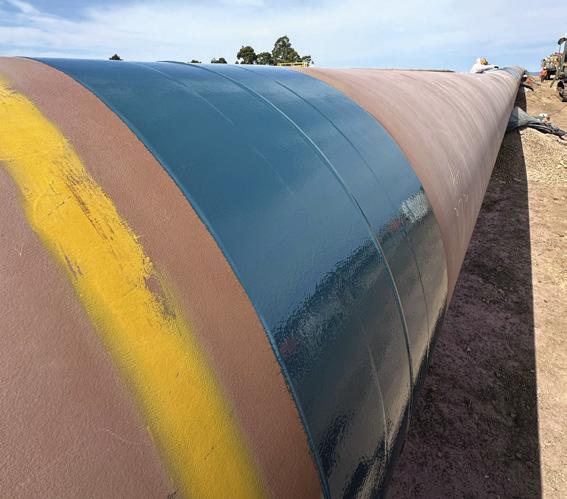
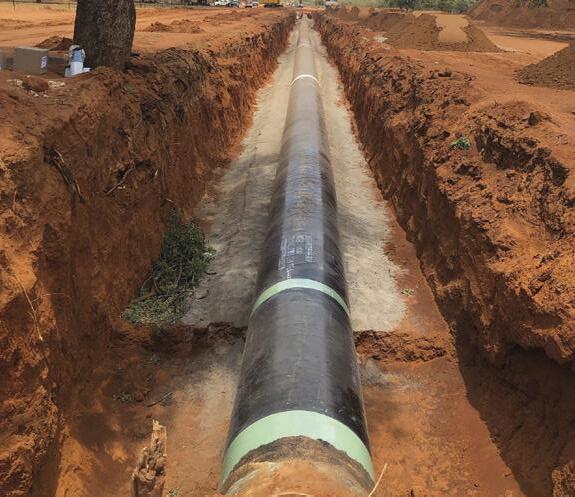
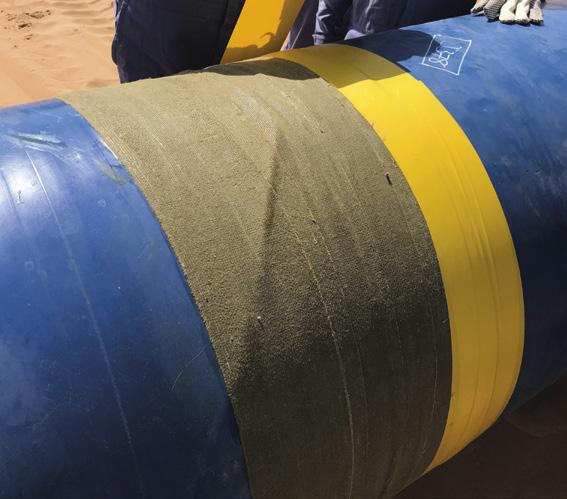





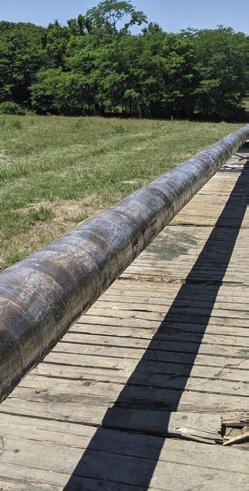




World Pipelines’ Contributing Editor, Gordon Cope, studies the future of the global midstream hydrogen economy.
nce considered the realm of science fiction, the hydrogen economy is now achieving reality. A combination of environmental goals and the spectre of energy warfare has super-charged its implementation.
The EU is leading the way. Over €13 billion has been earmarked for improving hydrogen technology, production and demand. Analysts calculate that approximately US$23 billion is needed to build offshore wind farms to generate an estimated 300 terawatt hours (TWh) of power, enough to create up to 15% of the estimated hydrogen consumption in 2050.
The Netherlands has launched an ambitious plan. Up to 700 MW of generation has been slated for the Ten noorden van de Waddeneilanden site in Dutch waters. In late 2023, Dutch gas network operator Gasunie began pipeline construction near the port of Rotterdam, with the intention of connecting four regional hydrogen hubs by 2030 (although the company recently announced permitting issues and staffing problems have pushed that deadline out to 2033).
Germany is also pursuing an aggressive adoption policy. The core production and distribution network has been estimated to cost US$21.6 billion and extend for 9700 km, and would to be built by private investors and financed by user fees. Germany’s gas transmission association FNB Gas announced that the first 525 km of the hydrogen core grid would be built in 2025 by converting 507 km of existing gas pipe and building 18 km of new pipe. They estimated that the entire system would be completed by 2032.
Other countries have announced similar plans. Ireland is exploring a subsea pipeline to deliver hydrogen to Scotland, which would augment the designs that the Net Zero Technology Centre in Aberdeen has regarding converting the country’s abundant wind energy into exports. The Centre estimates that a newbuild hydrogen pipeline capable of meeting 10% of mainland Europe’s needs would cost £2.7 billion and be online by the mid-2030s.
Belgium’s gas transmission operator Fluxys plans to spend US$2.19 billion on a hydrogen pipeline network that would connect Dunkirk, Zeebrugge, Ghent, Antwerp, Liege, Cherlero, Mons and Brussels by 2033.
UK-firm HyNet is planning an 85 km dedicated-hydrogen pipeline network that will be the backbone of its plan to supply the industrial region of Liverpool with low carbon energy. In phase 1, blue hydrogen will be produced and consumed at the Stanlow Manufacturing Complex and nearby off-takers. Phase 2 will see up to 270 km of new pipe extended throughout the region to serve regional utilities. In addition, salt caverns will be converted to hydrogen storage in order to smooth supply and demand profiles.
When it comes to rolling the EU network out, however, significant technological and economic challenges exist. For instance, AC transmission of electricity from offshore wind farms faces unacceptable power losses as distances exceed 100 km. One way to avoid losses is Power to Gas (P2G), in which seawater is desalinated as feedstock in order to create hydrogen through electrolysis on-site, then transporting the gas to shore via repurposed natural gas pipelines. While research is focusing on surmounting technical difficulties, transferring such a mass of new technology to industrial scale at an offshore site will be fraught with difficulties.
Secondly, hydrogen causes embrittlement in traditional steel pipelines, creating the potential for catastrophic failure. Holland’s Gasunie asserts that existing gas networks are safe, while international experts express doubts, causing implementation delays. German utility giant Uniper, which is part of Gasunie’s plan to build the Delta Rhine Corridor (DRC) to connect the Port of Rotterdam to Germany, has spoken publicly about its concerns over the delays that are pushing commissioning from 2030 to 2034. In September 2024, the expected approval of Germany’s core hydrogen pipeline network by the country’s Federal Network Agency was also delayed due to redesign issues.
African nations are eyeing the immense market in Europe and making plans. Algeria is keen to leverage its abundant solar and wind power to deliver low-carbon hydrogen to the EU. State-owned energy firms Sonatrach and partners have signed a memorandum of understanding with Italian grid operator Snam, VNG of Germany, and Austria’s Verbund to launch feasibility studies for large-scale green hydrogen production and a pipeline network across the Mediterranean. Tunis is also eager to participate. Germany and Italy
are planning a hydrogen-ready pipeline, dubbed SoutH2, that would receive gas from Tunisia and deliver it to northern Europe.
While abundant supplies of cheap natural gas makes security concerns in North America far less onerous than Europe, both Ottawa and Washington have imposed net-zero goals by 2050 on wide swathes of their economies. As part of the goals, they have followed up with multi-billion-dollar subsidies, research grants and tax incentives to promote hydrogen.
Major refining sectors in Alberta and the US Gulf Coast (USGC) already possess hydrogen pipeline networks. In the latter, over 2500 km of dedicated pipelines move several million tpy of hydrogen from its sources of manufacture to refineries and petrochemical plants.
Spurred by incentives of up to US$3/kg, hydrogen manufacturers are investing in solar/wind farms, electrolysis plants, and carbon capture and sequestration (CCS) systems. Air Liquide has 20 plants in the USGC and operates over 900 km of the regional hydrogen pipeline network. In order to supply commercial quantities of low-carbon hydrogen, the company is building the Blue Energy Complex in Louisiana. As part of the complex, Air Liquide is installing a module to produce 750 million ft3/d of blue hydrogen. The system will capture up to 95% of CO2 from its auto-thermal reforming (ATR) unit; in all, the complex will permanently sequester 5 million tpy under nearby Lake Maurepas.
In Canada, Air Products is building a revolutionary hydrogen energy complex in the Fort Saskatchewan industrial region near Edmonton, Alberta. The CAN$1.6 billion facility will create 2200 tpy of blue hydrogen, also using ATR. Air Products will then use its 55 km pipeline network to deliver blue hydrogen to Shell’s diesel refinery, as well as to third parties in the industrial region.
Engineering trials have shown that blends of up to 5% hydrogen do not cause steel embrittlement, and there is widespread interest among North American utilities to mix low-carbon hydrogen into existing pipeline networks. New Jersey Resources Corp. is building a green hydrogen project in Howell, New Jersey, and will inject the output into its system. Atlanta-based Southern Company, which serves over four million customers, is experimenting with gas/hydrogen blends in its infrastructure. Virginia-based Dominion Energy is pursuing a 5% blend of hydrogen in their natural gas pipelines.
The state of California is taking the next step. It is using a US$1.2 billion grant from the US Department of Energy to create a regional clean hydrogen hub, to be operational by the end of 2033, that will supply a wide array of industrial users. As part of the initiative, Southern California Gas (SoCalGas) is developing Angeles Link, a dedicated, green hydrogen pipeline system that could deliver enough hydrogen to displace the equivalent of 3 million gal./d of diesel fuel. The pipeline would likely originate in the wind and solar-rich desert east of Los Angeles, where third parties would produce the low-carbon hydrogen, and terminate within the Los Angeles basin near current utility plants or the port of Los Angeles. In October 2024, Spain’s RIC announced plans to build a 1GW electrolyser plant on 300 acres in the Mojave Desert, 300 km east of Los Angeles. In December 2024, SoCalGas filed a state application to advance Phase 2, which would further extend the network beyond the boundaries of the Los Angeles basin.


integrated bypass maintains production during isolation











Dual Leak-Tight Seals
Double Block & Bleed Isolation





















Isolated Pipeline





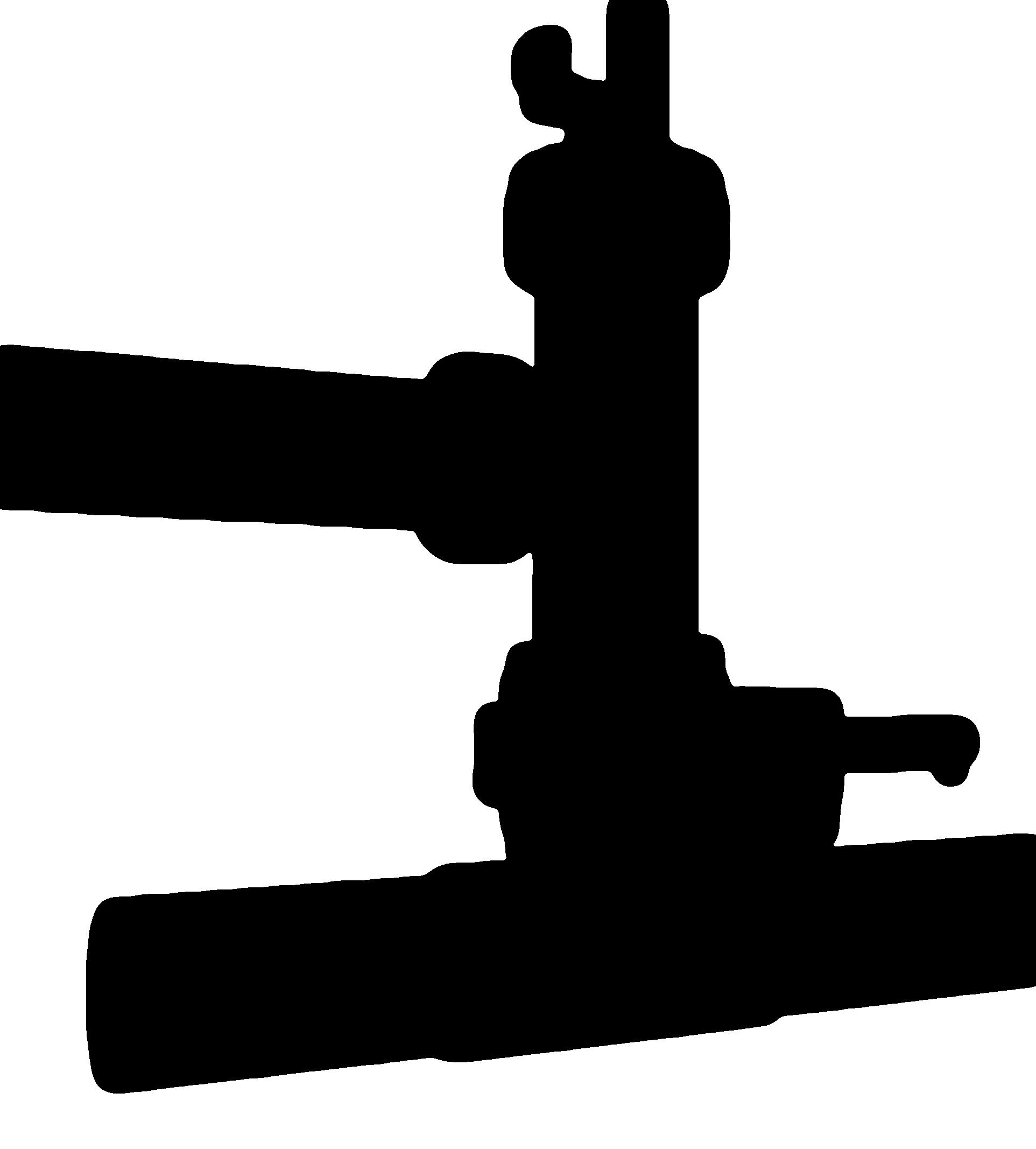








Monitored Zero-Energy Zone
The BISEP® has an ex tensive track record and provides pioneering double block and bleed isolation while
dual seals provide tested, proven and fully monitored leak-tight isolation, ever y time, any pressure.



















Jurisdictions throughout Asia have announced ambitious plans to participate in the hydrogen economy. In October 2024, the largest province in South Korea announced it would build a comprehensive clean hydrogen network. North Gyeongsan’s system will include a small, 100 MW nuclear reactor to produce ‘pink’ hydrogen through hydrolysis, and a 1000 km pipeline network to deliver the fuel to users.
China is the world’s largest producer of traditional hydrogen, with approximately 33 million tpy made from coal and natural gas. In 2022, Beijing announced a multi-decade plan to build a complete low-carbon hydrogen value chain; an initial goal of at least 100 000 tpy has been set for 2025. So far, 64 000 tpy of solar and wind-powered electrolysis capacity has been created by Sinopec and other energy firms, with the goal of adding another 160 000 tpy by the end of 2025. In January 2024, construction of the world’s longest hydrogen pipeline began. The line will stretch 737 km from a green hydrogen facility in the city of Zhangjiakou to the port of Caofeidian (located 250 km southeast of Beijing). Tangshan Haitai New Energy Technology and China Petroleum Pipeline Engineering Corporation, developers of the US$845 million line, say the project will promote the export of green hydrogen.
Japan is deficient in traditional fossil fuels, and views hydrogen as a next-generation energy source that will decrease GHG emissions and augment security. In addition to boosting hydrogen supplies from 4 million tpy to 12 million tpy by 2040, it is investing heavily in hydrogen-related research in order to power diverse sectors. Nippon Steel has converted a blast furnace to hydrogen, lowering CO2 /t emissions by 33%. Tokyo Gas, which imports almost 13 million tpy of LNG, intends to blend e-methane and hydrogen into its distribution system. In March 2024, it also launched a hydrogen pipeline network to deliver fuel to the former residence of athletes at the Tokyo Olympics and Paralympics.
In February 2024, refiner Idemitsu Kosan announced it would build a 10 000 tpy green hydrogen plant in partnership with Hokuden, a utility located on Japan’s northernmost island of Hokkaido. The plant will be built in the port of Tomakomai and connected to the refinery via pipeline. Idemitsu is also participating in ExxonMobil’s planned 900 000 tpy low-carbon hydrogen and ammonia plant in Baytown, Texas. The plan is to offtake ammonia and deliver it to the company’s import terminal in Shunan City, on the island of Honshu, where it will be subsequently distributed to industries and utilities for combustion.
The hydrogen economy faces a daunting task; how do you finance a new form of fuel when there are no takers? BNEF, a consultancy, estimates that just 12% of proposed clean hydrogen projects have contracted off-takers. “No sane project developer is going to start producing hydrogen without having a buyer for it, and no sane banker is going to lend money to a project developer without reasonable confidence that someone’s going to buy the hydrogen,” noted a BNEF analyst.1
The paucity of firm contracts is forcing producers to rethink projects. In September 2024, Shell, citing lack of market demand, cancelled plans to build a low-carbon hydrogen plant on Norway’s west coast. The same month, Equinor also announced that it would not build a pipeline designed to carry up to 10 GW of blue
hydrogen from Norway to Germany, citing a lack of customers and uncertain regulatory framework. In October 2024, Spain’s Repsol announced that it would pause 350 MW of electrolysis capacity in its home country, due to tax policy and demand concerns.
Plans to build pipelines are also getting ahead of the regulatory framework necessary to grant permissions and certify safety. In North America, several states, including Texas and North Dakota, have passed legislation allowing intra-state networks, but any efforts to cross borders run into a roadblock. The Department of Energy’s (DOE) Federal Energy Regulatory Commission (FERC) is responsible for interstate natural gas lines, but doesn’t have the authority to approve hydrogen pipelines. While some call for federal regulations, others worry that an overreaching bureaucracy would stifle nascent initiatives with red tape.
A very large question looms over the future of the hydrogen economy; the discovery of white, or natural hydrogen deposits. Virtually ignored by energy companies until very recently, it turns out that the earth has enough to last for several millennia; the USGS speculates that there could be as much as 5 trillion t beneath the ground. Geologists are piecing together where it is being produced (where water comes in contact with basalts), and coalescing into reservoirs (similar to gas traps). Currently, there are over forty companies searching worldwide for economic deposits, including Canadian, Australian, American and European firms.
This may not be all bad. While the spectre of stranding expensive electrolysis plants hangs over the sector, natural hydrogen may turn out to be a blessing in disguise. Experience with unconventional resources has revealed that it now takes about two decades for new sources of energy to dominate the market (shale gas went from virtually nothing in 2005 to now accounting for the majority of the 115 billion ft3/d produced in North America). In the space of the next decade, the cost of green hydrogen is expected to approach the magic US$1/kg range through advances in technology. At the same time, discoveries of cheap natural hydrogen reservoirs will gain traction. Green hydrogen plants can be built anywhere (normally near refineries and such), while hydrogen reservoirs will require extensive pipeline networks to deliver to market.
While the former will enrich solar and wind power producers, the latter will benefit the midstream sector.
The rollout of the hydrogen economy will likely proceed in a patchwork manner as governments, energy producers and industrial consumers wrestle with mandates, markets and demand. The EU will continue to nurture its development, spurred by both net-zero legislation and energy security concerns. The Chinese government has sent a clear message to state-owned enterprises; full steam ahead. Japan, with its eye to the future, will continue to invest heavily in R&D and infrastructure. The Trump administration has expressed its aversion to hydrogen subsidies and tax breaks and will likely put the brakes on some North American projects. Regardless, pipeline companies will play an integral part in those projects that succeed, facing significant risks as well as substantial rewards.
References
1. https://oilprice.com/Latest-Energy-News/World-News/Shell-AbandonsNorways-Hydrogen-Projects-Due-To-Lack-Of-Demand.html


CLEAN & PROFILE IN A SINGLE STEP

NEAR WHITE/ WHITE METAL CLEANLINESS
he hydrogen sector in Europe is at a critical crossroads, with stakeholders navigating varying levels of readiness. Transportation stakeholders, for example, benefit from a relatively structured regulatory environment, enabling them to push forward. By contrast, other key players, such as offtakers, operate within uncertain conditions that hinder the development of the sector as a whole. This uneven playing field highlights an urgent need for alignment across the supply chain, particularly as Europe pushes toward its ambitious decarbonisation goals.
Regulatory clarity: uneven ground for stakeholders
Regulations play an essential role in shaping the low-emission molecule and hydrogen market. While the European Union has made significant progress in establishing directives, such as those governing ‘green’ hydrogen and Renewable Fuels of Non-Biological Origin (RFNBO), many Member States lag in transposing these directives into national legislation. This delay creates an uneven environment for stakeholders.

Kimberly Sari, ILF Consulting Engineers, highlights the necessary changes and alignment to push Europe’s hydrogen sector past its tipping point.
Transportation stakeholders benefit from clearer regulatory structures, such as those guiding the repurposing of natural gas pipelines for hydrogen transport and storage. This regulatory certainty allows them to make informed decisions and implement long-term plans. However, developers and offtakers face greater uncertainty. For developers, ambiguity in standards, particularly around the classification of ‘low-carbon’ hydrogen, complicates project planning and investment decisions. For offtakers, the lack of a consistent framework for hydrogen use across sectors, such as maritime and heavy industry, reduces confidence in committing to long-term agreements.
The EU’s ‘Fit for 55’ package offers a roadmap for cutting greenhouse gas emissions by 55% by 2030. However, achieving these targets requires more than ambitious legislation. It demands coordinated efforts among stakeholders across the value chain, from policymakers and financiers to developers and offtakers. Without a clear regulatory environment for all stakeholders, these efforts remain fragmented, slowing the pace of development.
Financing: a misalignment of needs and risks
Financing remains one of the most significant bottlenecks in Europe’s low-emission molecule and hydrogen market. The financial sector is well-established and ready to invest in low-emission molecule projects, but its traditional risk management tools are often incompatible with the unique challenges of these projects. Developers struggle to demonstrate bankability due to high upfront costs,
extended project timelines, and a lack of long-term offtake agreements that would secure revenue streams.
This misalignment leaves even the most promising projects at a standstill. Public financial institutions like the European Hydrogen Bank and initiatives like H2Global are working to mitigate these early-stage risks by providing auctions and guarantees that attract private investment. While these mechanisms are helpful, they are not sufficient to meet the sector’s growing needs.
Risk-sharing remains a key issue. The short- to mediumterm planning preferences of offtakers clash with the longterm financial commitments required by developers and financiers. This mismatch creates a vicious cycle: offtakers are hesitant to commit without established infrastructure and stable pricing, while developers cannot secure financing or proceed with projects without those commitments. Breaking this cycle requires innovative solutions, including government-backed guarantees, new financing tools, and stronger collaboration between stakeholders.
Developers: leading the charge despite hurdles
Among all stakeholder groups, developers have made the most progress in preparing for a low-emission molecule and hydrogen-driven future. They are actively working on large-scale production and import projects to meet Europe’s ambitious targets. However, their efforts are frequently stymied by two major obstacles: difficulties in obtaining financing and the absence of long-term agreements with offtakers.





Securing a final investment decision (FID) for capital-intensive hydrogen projects requires careful planning in both engineering and financing. Developers must navigate tight deadlines, evolving regulatory requirements, and high levels of financial risk. These challenges are further compounded by the absence of long-term commitments from offtakers, who often prefer flexible, short-term arrangements that allow them to adapt to energy price volatility. Despite these challenges, developers remain optimistic about the future. High-level political support, substantial engineering solutions, and the potential to repurpose existing natural gas infrastructure provide a foundation for growth. However, to accelerate progress, developers need stronger commitments from other stakeholders, particularly financial institutions and offtakers.
The transportation and storage of hydrogen present another set of challenges. Europe’s existing infrastructure is insufficient to support the intercontinental transportation of low-emission molecules and hydrogen and its domestic distribution within the continent. Key investments are needed to expand ports, pipelines, and storage facilities. Repurposing existing natural gas infrastructure offers a practical solution for some of these challenges. For


Versatile
High Strength
Convenient
Corrosion Resistant
Excellent Cost-to-Strength Ratio
Conformable
AQUAWRAP:
Low Cost
Simple and Easy-to-Use – Just “Rip & Wrap”
Cures in Wet Conditions and Underwater
Excellent Toughness – Resists Cracking
Heat Resistant to 250°F.
Non-Hazardous
30-Minute Working Time,
Perfect for Long Installations
High Strength



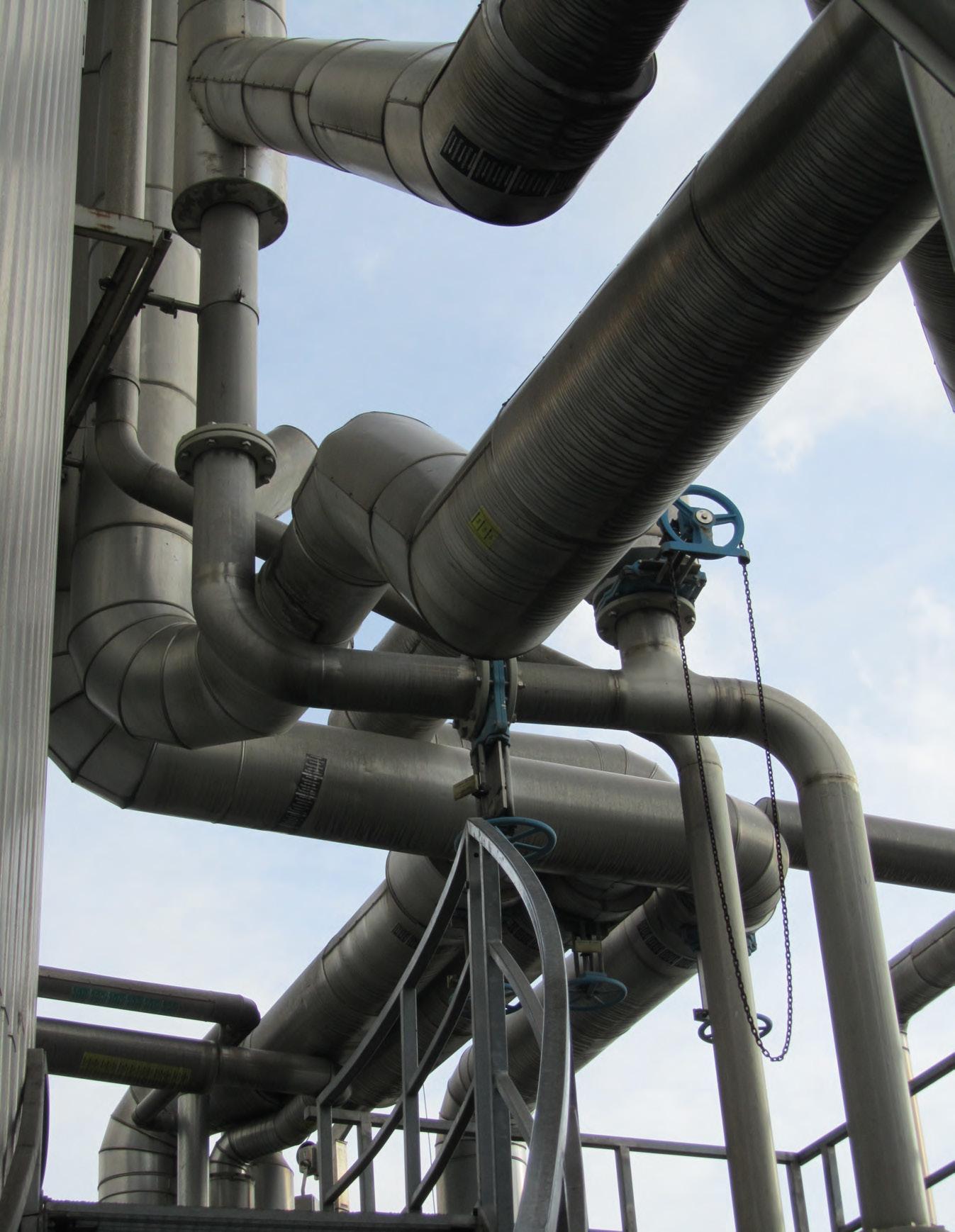

instance, converting natural gas pipelines into hydrogen pipelines could reduce costs and accelerate deployment. Cavern storage also holds significant potential for stabilising supply, particularly as hydrogen production scales up.
The main hurdle in infrastructure development is timing. The rapid growth of hydrogen demand requires infrastructure to expand at a similar pace. This necessitates close coordination among transmission system operators, government agencies, developers, and offtakers. Without proactive investment and planning, infrastructure bottlenecks could stall the market’s development.
Offtakers hold the key to unlocking the full potential of Europe’s low-emission molecule and hydrogen market. Their willingness to enter into long-term purchase agreements provides the revenue certainty developers need to secure financing and move projects forward. However, many offtakers remain hesitant due to regulatory uncertainty and the lack of a clear business case for hydrogen adoption.
To address this hesitancy, policymakers must establish clearer regulations and quotas for hydrogen use across industries. These measures will provide the market signals offtakers need to commit to long-term agreements. Additionally, pricing models that reflect the green premium of low-emission hydrogen should be standardised to support early adopters.
Financial tools and policy mechanisms can also play a role in reducing ‘first-mover’ risk for offtakers. By providing guarantees or subsidies, governments can encourage companies to take the initial steps toward hydrogen
adoption. These commitments will, in turn, create a ripple effect, enabling developers to secure financing and accelerating the overall market cycle.
The low-emission molecule and hydrogen market is stuck in a classic “chicken-and-egg” dilemma. Developers need offtakers to commit before they can secure financing, while offtakers need a reliable supply and clear market conditions before they can commit. This cycle of hesitation slows progress and jeopardises Europe’s decarbonisation goals.
Breaking this cycle requires coordinated action across the stakeholder value chain. Governments must step in to provide early-stage support through subsidies, guarantees, and public-private partnerships. Developers and offtakers must work together to establish long-term agreements that align with the needs of both parties. Financial institutions, in turn, must adapt their risk management tools to better align with the realities of low-emission molecule and hydrogen projects.
The recently published white paper, Low-Emission Molecules: Insights into an Emerging Sector, offers valuable insights into these challenges. Based on interviews with 31 industry managers, the paper highlights the barriers and opportunities within the low-emission molecule and hydrogen market and provides actionable recommendations for accelerating progress.
Key strategies include decoupling production from offtake, fostering vertical cooperation among stakeholders, regulating the transport of low-emission molecules, establishing strategic hydrogen reserves, protecting first movers, and adopting business case hedging. These recommendations provide a roadmap for stakeholders to overcome current challenges and create a more integrated, efficient hydrogen market.
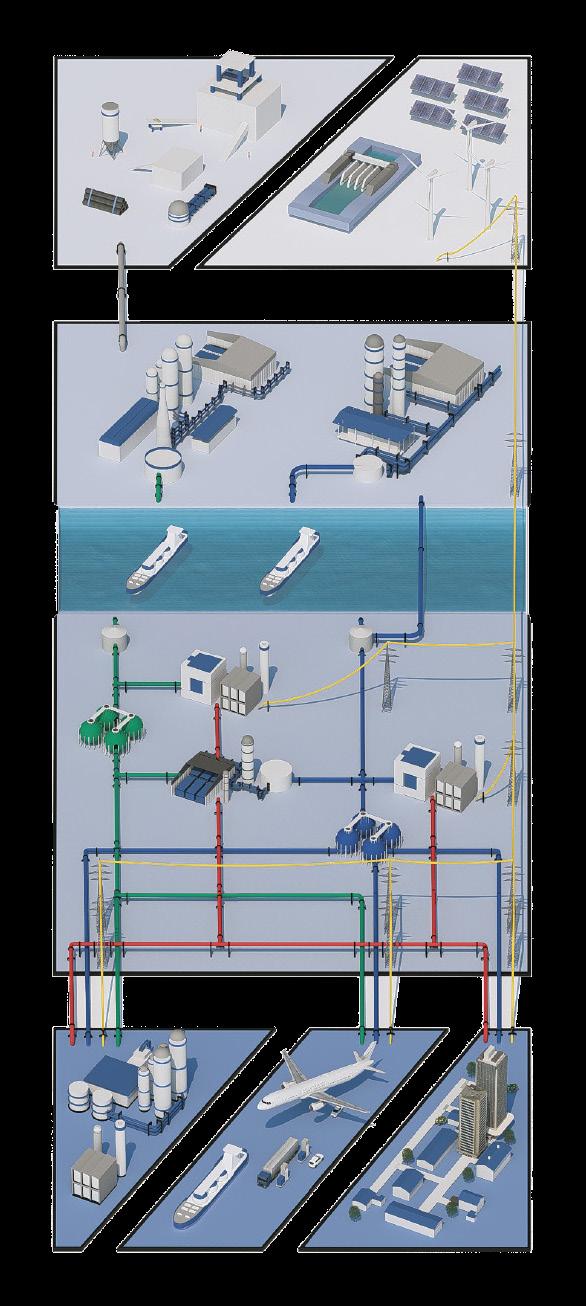
As Europe races to meet its decarbonisation targets, the hydrogen market must accelerate its development. This requires stronger collaboration, clearer regulations, and innovative financing solutions. By addressing the current misalignments and breaking the cycle of hesitation, stakeholders can unlock the full potential of low-emission molecules and hydrogen as a key driver of the energy transition.
The findings of the white paper serve as a vital resource for policymakers, developers, financiers, and offtakers. With coordinated efforts and a shared commitment to progress, the hydrogen market can overcome its current challenges and drive the clean energy future in Europe.
Niamh Rogers, Lucie Dangeon-Vassal and Rémy Maury, Cesame-Exadebit, present an initiative for flow measurement traceability for hydrogen in gas networks.

o mitigate the most severe consequences of climate change, it is imperative to significantly decrease greenhouse gas emissions. Achieving this goal necessitates a reduction in Europe’s dependence on fossil fuels, as well as the rest of the worlds.
Hydrogen presents a viable and sustainable alternative, capable of being transported and distributed across long distances through gas networks while addressing societal, economic, ecological and technological objectives. Seasonal or daily hydrogen storage can be performed underground, or in the existing natural gas networks,
enabling it to match energy demands with unforecastable and variable renewable energy sources like solar and wind. Gas Distribution System Operators (DSOs) and Transmission System Operators (TSOs) are central actors, as they will transport hydrogen using repurposed and new pipelines across Europe, with over 57 000 km of hydrogen pipelines by 2040.6 In fact, the European Network of Network Operators for Hydrogen (ENNOH) has been established in 2025 to support this extensive network.7
The European Union is dedicated to establishing Europe as the first climate-neutral continent by 2050. Realising this ambitious objective necessitates a comprehensive overhaul of the European energy system, which is responsible for over 75% of the EU’s greenhouse gas emissions.1 To achieve these targets, many technological innovations are essential and, focusing on hydrogen, an acceleration on the development of a dedicated infrastructure is expected. Pipelines are considered the most effective means of transporting large quantities of hydrogen, particularly across extended distances.9 Nevertheless, the existing deficiency in infrastructure poses a significant barrier to this progress.
Recent research at the European Gas Research Group outlines that due to hydrogen’s lower calorific value, the energy conveyed by pipelines is lower than that of natural gas, from a volumetric standpoint. Therefore, a significant increase in the gas velocity in the pipeline is necessary to compensate for the lower energy value per cubic metre if the operative pressure is maintained around the values typical for existing natural gas networks.8 Despite largescale decarbonised hydrogen projects proliferating across the world, there is currently a lack of capability to conduct calibrations for pure hydrogen within gas networks. Such capability is urgently needed to establish the link between hydrogen flowmeters and the SI-units of measurement. Existing natural gas network measurements heavily rely on calibrated flowmeters to ensure the accuracy of their readouts and avoid any biases when trading takes place. Successful supply chain management hinges on precise measurements; therefore, without them, the penetration of the hydrogen market as envisioned by decision makers will not be achievable.
Developing calibration capability for pure hydrogen flow in gas networks
Recently, a project dealing with the capability to calibrate hydrogen flowmeters at high pressures and high flowrates in the typical range of gas networks was developed. The project is called H2FlowTrace. On 1 September 2024, the H2FlowTrace initiative was launched, consisting of 17 partners from 11 different European nations, co-financed by EURAMET, coordinated by Cesame-Exadebit. The consortium unites National Metrology Institutes (NMIs), and Designated Institutes (DIs) specialised in flow measurement, gas metrology, and the assessment of physical properties. This project is further enhanced by the inclusion of research institutes, industrial entities and a university. The multidisciplinary and collective knowledge and expertise in flow measurement within the consortium will be leveraged to tackle the measurement challenges associated with hydrogen flowmetering (as well as those associated with hydrogenenriched natural gas (HENG), in order to enhance energy management benefits.)
The 36 month project is currently at the seventh month, making good progress. The project will be completed in August 2028.
The consortium aims to rectify the deficiency by facilitating the establishment of a large-scale verified metrological framework through the development of metrological infrastructures across a wide flow spectrum, so that calibrations of pure hydrogen and HENG flowmeters can be performed in which traceability to the SI-units of measurement is established. This development holds the potential to strengthen Europe’s prominent role in the hydrogen economy.
H2FlowTrace seeks to address this challenge. The primary goal is to create a system for tracking gas flow of hydrogen within gas networks. The specific aims include:
1. To establish a robust metrological infrastructure (Figure 1): for flowrates up to 1300 m3/h at 0.1 MPa(g) or 45 m3/h at 3.3 MPa(g) with a primary focus on pure hydrogen but also enabling traceability for HENG blends in small industrial meters, with a measurement uncertainty of 0.20% or less.

2. To establish a robust metrological infrastructure for flowrates of 200 m3/h to 10 000 m3/h, and pressures of 0.3 MPa(g) to 6.2 MPa(g) for pure hydrogen and HENG blends in large industrial meters, with a measurement uncertainty of 0.30% or less.
3. To design and test traceability transfer skids for pure hydrogen and HENG blends. In addition, to carry out intercomparisons to determine the equivalence of independent traceability chains based on primary standards, secondary standards using a bootstrapping/upscaling approach, and secondary standards calibrated with alternative fluids to hydrogen.


Once a pipeline is in production, debris within the system can be more extreme, with sand or scale or wax deposits. This can require more specialist pigs to be used, where designs are more focused and offer the ability to be adjusted as part of a progressive cleaning programme.
Propipe pigs are designed specifically for each pipeline and offer optimum performance to maintain maximum production pressures and flow.
Standard Pigs - No Bypass

Propipe Pigs with Bypass

Full testing facilities and the Trident pig tracking range are available.


4. To perform (i) primary calibrations of domestic gas meters (ultrasonic, diaphragm, thermal mass flow) with air and/ or methane and with pure hydrogen up to 30 m3/h at atmospheric pressure, and (ii) primary and secondary calibrations of industrial gas meters (ultrasonic, rotary, turbine) with air and/or natural gas and hydrogen/natural gas blends at flowrates of up to 1000 m3/h and pressures of up to 6.2 MPa(g). Based on these results as well as existing data, to deliver statistically meaningful datasets for air, natural gas, or other alternative fluid calibration for the transferability to hydrogen gas flow conditions for domestic and industrial flowmeters.
5. To demonstrate the establishment of an integrated European metrology infrastructure and to facilitate the take up of the technology and measurement infrastructure developed in the project by the measurement supply chain (accredited calibration and testing laboratories, European Metrology Network for Energy Gases), standards developing organisations (ISO/TC 30, OIML TC 8/SC 7, CEN/TC 237) and end users (energy gas transmission, distribution operators, FARECOGAZ, ENTSOG, Hydrogen Europe).
This project further aims to integrate the SI traceability of measurement institutions with the capability of key industrial stakeholders to transport hydrogen at the required flowrates and pressure levels.
As previously stated, the European Union aims to establish a carbon-neutral environment by 2050,1 while also setting specific climate and energy objectives by 2030, with hydrogen potentially playing a crucial role in this endeavour.4
The EU’s initiatives for energy system integration and hydrogen development are instrumental in achieving these goals, supported by frameworks such as the Next Generation EU Recovery Package,2 the European Green Deal,3 and the EU Hydrogen Strategy.4 Nevertheless, the journey will encounter various technical challenges. Hydrogen is pivotal for facilitating the energy transition, offering the capability to carry renewable energy minimising the use of fossil fuels, and serving as both short-term and long-term energy storage to address supply intermittency.
The expansion of hydrogen utilisation is significantly reliant on metrology (the science of measurement), necessitating a
robust metrological infrastructure for accurate hydrogen flow measurement, which will be addressed through objectives 1, 2, and 3. Objective 4 focuses on generating new insights regarding the compatibility of different meter types with hydrogen. Establishing best practices and ensuring traceability to the SI units of measurement in hydrogen flows will be vital for the efficient operation of decarbonised gas networks. In the long run, this will foster trust in billing, fiscal and custody transfer measurements, and maintain public support for the transition to net-zero carbon dioxide emissions. Ultimately, this will contribute to a positive environmental outcome. Furthermore, the use of hydrogen as a fuel in the automobile industry could greatly diminish greenhouse gas emissions in the future, further permitting the ability to achieve the EU’s objectives. For example, positive effects have been already seen in the past since improved traceability for hydrogen flow measurement significantly bolsters the approval process for hydrogen refuelling stations. This advancement could enable the market of hydrogen-powered vehicles, including public transport buses, trucks, and cars, thereby contributing to a reduction in greenhouse gas emissions and the consumption of fossil fuels. At the border separating two nations, flowmeters are installed to facilitate the sale of energy in transit. However, in the context of hydrogen networks, there is currently no infrastructure that is metrologically linked to the International System of Units (SI) for the calibration of these meters. The H2FlowTrace initiative aims to address this deficiency by developing two mobile skids (SSTS and LSTS) designed to accommodate a broad spectrum of flowrates, thereby meeting the requirements of gas transporters within the networks.
This project aims to develop an integrated service for the measurement of traceable hydrogen (blend) gas flow, which will enhance metrological traceability with SI-units for gas networks. In domestic applications, datasets will facilitate the assessment of transferability of calibrations using alternative to hydrogen fluids in gas flow applications. This is crucial for promoting hydrogen as a viable energy source, as establishing flow measurement traceability is essential for gaining the trust of consumers and gas meter manufacturers in achieving the necessary accuracy standards for measuring hydrogen and/or HENG. Meter manufacturers will benefit from new traceable calibration facilities, allowing them to conduct research and development with pure hydrogen at flowrates and pressures

pertinent to large industrial meters. Consequently, industry end users will be empowered to make informed choices since manufacturers will be able to better assist end-users in their decisions regarding hydrogen flowmeters, backed by the metrology community and validated calibration facilities.
Moreover, the datasets produced through this initiative will allow the consortium to evaluate the reliability and cost-effectiveness of calibrations using alternative fluids (HENG, natural gas, nitrogen, water, etc.) for various types of gas meters, including ultrasonic flow, thermal mass flow, diaphragm, and Coriolis meters. Consequently, this will lead to significant cost reductions for testing and calibration laboratories. Ultimately, this will facilitate a rapid increase in the use of hydrogen and HENG, with minimal modifications required to the existing metrological infrastructure. Furthermore, establishing metrological traceability for hydrogen and HENG gas flow in industrial settings will enable the current test loops within the consortium to gain full confidence in the calibrations they conduct for industrial clients.5 The comparison of hydrogen and HENG facilities, along with a comprehensive calibration campaign involving at least 40 industrial gas meters, will serve as a fundamental element for creating a metrologically harmonised hydrogen and HENG transmission infrastructure.
Ensuring the accuracy, repeatability, traceability, and costeffectiveness of flow measurement is essential for fostering the sustainable development of the hydrogen sector in Europe and eventually the world. This focus will contribute to
a more robust market for hydrogen technology and service providers, thereby stimulating innovation and creating new job opportunities for citizens across the continent. The long-term effects of this initiative will include facilitating manufacturers in the design and certification of advanced flowmeters, as well as empowering gas network operators to advance their hydrogen infrastructure projects.
1. European Commission, ‘A European Green Deal’, https://ec.europa.eu/info/ strategy/priorities-2019-2024/european-green-deal_en published 3 October 2022, accessed: 13 January 2025.
2. European Union: NextGenerationEU, https://europa.eu/next-generation-eu/ index_en published 3 October 2022, accessed 13 January 2025.
3. European Commission, ‘A European Green Deal’, https://ec.europa.eu/ commission/presscorner/detail/e%20n/ip_19_6691 published 3 October 2022 accessed 13 January 2025.
4. European Commission, ‘A hydrogen strategy for a climate-neutral Europe’, https://ec.europa.eu/energy/sites/ener/files/hydrogen_strategy.pdf published 3 October 2022, accessed 13 January 2025.
5. SALEEM, M.A., and RIEZEBOS, H., ‘JIP renewable gases; results on performance of turbine and ultrasonic flow meters up to 30 % Hydrogen and 20 % CO2’, in North Sea Flow Measurement Workshop, 2021. Accessed 13 January 2025.
6. European Hydrogen Backbone, ‘EHB initiative to provide insights on infrastructure development by 2030’, https://ehb.eu/files/downloads/EHB-initiative-toprovide-insights-on-infrastructure-development-by-2030.pdf published 10 July 2023, accessed 13 January 2025.
7. ENNOH, The European Network of Network Operators for Hydrogen, https:// ennoh.eu/the-future-HTNOs-take-a-step-further-towards-the-establishment-ofENNOH.html, published December 2024, accessed 13 January 2025.
8. European Gas Research Group (GERG), ‘Determining Energy Capacity for H2 in existing NG pipelines’, https://www.gerg.eu/wp-content/uploads/2022/07/ GERG-Energy-Capacity-final-publishable-summary.pdf, published November 2023, accessed 13 January 2025.
9. Hydrogen transportation and distribution (p 187 - 224), https://www. sciencedirect.com/science/article/abs/pii/B9780323955539000030, published 2024, accessed 13 January 2025.











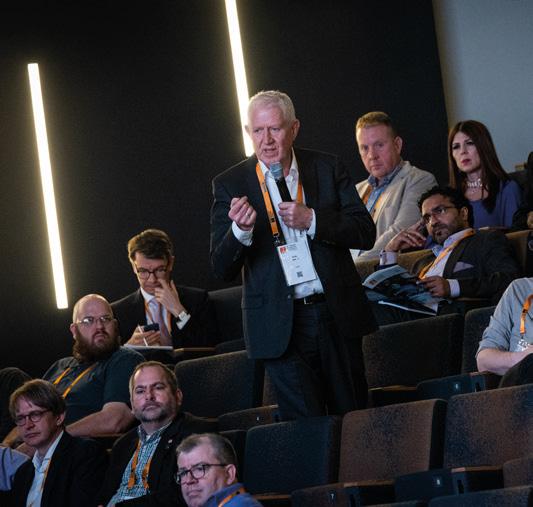



Jason Blubaugh, Corporate
Account Manager-ConFab, Miller
Electric Mfg. Co. argues that it is necessary for pipeline operators to begin a progressive approach to pipeline welding by adopting new technologies and methods.

ipelines move energy products over long distances and are a critical component to a nation’s infrastructure, making the integrity of their construction paramount to mitigating failures and environmental disasters. Deemed one of the most challenging types of welding, pipeline welders face complex welding positioning, harsh working environments and the need
for precision, adaptability and extensive knowledge of pipe materials and corresponding filler metals. These factors present themselves at varying times, and it’s a welder’s job to work through any adversity to still produce robust, high-quality welds suitable for their intended service application.
For oil and gas pipelines specifically, there’s increased scrutiny around weld quality and longevity – and the expectations in front of pipe welders today are significantly different than what they were just decades ago. Pipeline material manufacturing practices are everevolving, regulatory environments are ever-changing, and there are many additional enhanced requirements on project execution and maintenance work.
As such, welders need extensive training and the right certifications to demonstrate proficiency in the demands of pipeline welding. There must be adherence to strict quality standards, where rigorous welding codes, standards and regulations must be administered and met. Multiple weld passes adhering to a detailed welding procedure specification are applied to produce sound, workmanlike weld quality. The completed welds are inspected for defects using various non-destructive testing methods, such that any welds that don’t meet acceptance criteria standards are repaired or sometimes entirely cut out – a time-consuming and costly setback. The pressure and stakes are high.
For Enbridge, a North American energy company, the demand for quality, practicality, consistency and efficiency has never been more imperative. The conventional welding practices known and used for decades aren’t always suitable for today’s modern materials or the design
parameters required on some pipelines. Looking at the enhanced design requirements for modern pipelines, as well as the regulatory landscape, Enbridge sought to expand its pipe welding toolbox with new methods, and long-time partner Miller Electric Mfg. Co. assisted Enbridge with the new challenges it was experiencing. Miller supported the energy company in evaluating and incorporating advanced welding equipment and processes that would provide additional capabilities for more advanced applications.
When designing and constructing high-strength, straintolerant pipelines, welding engineering is critical when accounting for girth weld mechanical properties in addition to base material strengths and chemical compositions for the materials being welded. With the advancements of modern steel and pipe manufacturing practices in the interest of weldability, mechanical properties, quality and costs, it remains paramount that weld strength overmatching be considered when selecting appropriate welding processes and consumable combinations to mitigate the risks of weld strength undermatching and heat-affected zone softening. These risks are further addressed via control of the mechanical properties and chemical compositions of the steel and line pipe being procured. Enbridge has implemented requirements within pipe manufacturing specifications to control upperbound yield and tensile strength limits along with defined chemical composition ranges.
On the field girth welding front, Enbridge also implemented requirements within field welding construction specifications requiring the use of lower heat input welding processes and higher-strength welding consumables for high-grade pipe. This further bolsters the approach of producing girth welds with adequate margins of strength overmatch versus the adjacent pipe materials being joined.
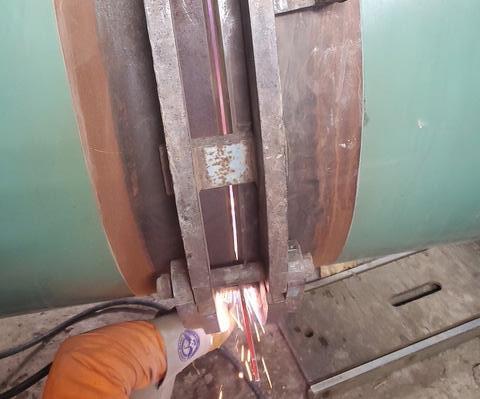
The shift toward lower heat input welding processes and higher strength welding consumables has resulted in the use of additional welding options to supplement conventional approaches. Oftentimes, this requires additional welder training and engagement with welding equipment and/ or consumable manufacturers to fine-tune products or support training efforts. The incorporation of additional welding options resulted in further interest and evaluation of alternative welding processes outside of conventional stick welding.
Manual shielded metal arc welding (SMAW, or stick rod welding) has been the preferred method among pipe welders and construction contractors for its ability
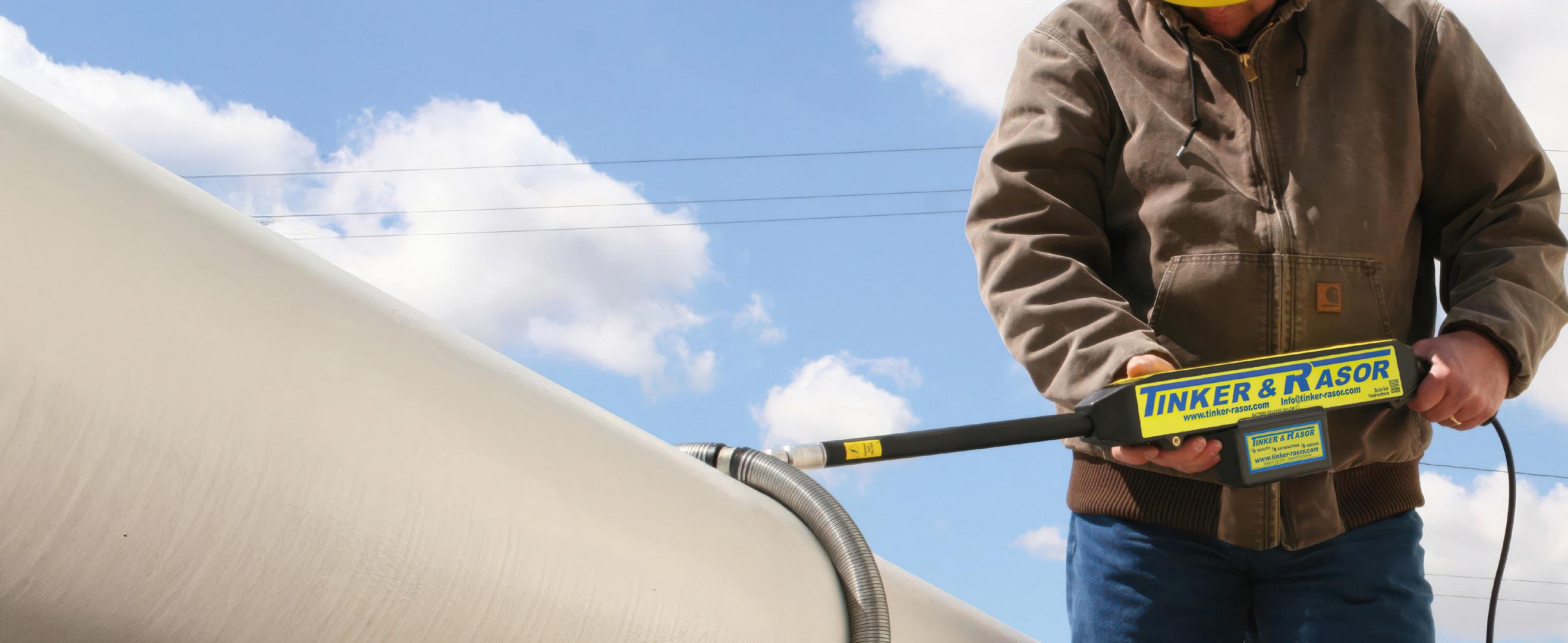
Since 1948, Tinker & Rasor has been a trusted name in holiday detection, relied upon by pipeline professionals worldwide. For over 76 years, our holiday detectors have set the benchmark for performance and reliability, ensuring the integrity of protective coatings by detecting coating flaws with precision. With a legacy of innovation and toughness, Tinker & Rasor continues to lead the industry, delivering cutting-edge solutions to safeguard pipeline coatings and maintain quality standards across the globe.



to reliably produce welds in nearly all environmental conditions since the flux coating on the electrode protects the weld from contamination. Cellulosic stick electrodes used for stick welding on pipelines use electrodes with a cellulose-based flux coating. Cellulosic electrodes like E6010 are especially popular in pipeline welding because of their ability to provide deep penetration and accommodate a multitude of challenging fit-up conditions in a rugged field environment.
When employing stick welding on cross-country pipelines, the root pass is typically installed in the downhill travel direction, with subsequent passes completed downhill using either a cellulosic or low-hydrogen downhill electrode, or alternatively, in an uphill travel direction using an uphill low-hydrogen consumable. All the various combinations have pros and cons and may be appealing to contractors or welders depending on proficiency of the work force, project-specific mechanical property requirements or other miscellaneous drivers. Advantages of low-hydrogen stick rod consumables, such as a very low hydrogen content, can be advantageous when attempting to mitigate risks of hydrogen-assisted cracking on susceptible materials, increasing weld metal strength or trying to reduce heat input, which would be common of a downhill low-hydrogen electrode with a faster travel speed, while conventional cellulosic-coated consumables may be appropriate for other applications.
Marrying pipe welding with RMD
Enbridge had its pulse on the industry – and took note of the increasing opportunities to supplement ongoing and future work with more semiautomatic and mechanised welding processes to offer improvement opportunities with respect to productivity, weld quality and mechanical properties of girth welds. Enbridge consulted with Miller to identify new, practical and efficient ways to produce high-quality welds suitable for modern day design and service conditions.
Understanding the heightened drive – and need –for high-quality welds, Miller recommended Enbridge begin implementing Regulated Metal Deposition (RMD®) MIG welding (modified short-circuit GMAW), using its ArcReach® Smart Feeder system paired with Hobart® MEGAFIL® 240M metal core filler metal.
ArcReach Smart Feeder delivers excellent RMD and pulsed MIG welding up to 200 ft away from the power source and without control cables. ArcReach capabilities allow parameters to be adjusted at the point of use on the feeder or remote to maximise productivity and minimise the time spent walking back to the power source. All of this amounts to increased uptime and improved jobsite safety. When out in the field, the Smart Feeder runs off the Miller® Big Blue® series engine drive power source. When plug-in power sources are possible, Miller suggested the XMT® 400 ArcReach®.
To obtain welds with consistent mechanical properties and chemical compositions and to minimise the risk of cracking in critical applications, the MEGAFIL 240M has the
properties needed for high-integrity welds and produces higher deposition rates than solid wire. It seamlessly bridges gaps if the fit-up is slightly askew and has excellent low-temperature impact toughness, which can be highly desirable to operators managing existing and constructing new pipeline systems in extreme cold climate regions.
Knowing the industry’s reputation for being averse to adopting new technology, Miller anticipated that many pipe welders were likely to be sceptical about implementing RMD welding – seeing stick welding as a trusted, tried-and-true process. Typical GMAW sees the short circuits occur at erratic intervals and with varying intensity. Producing codequality root passes with traditional short circuit GMAW requires significant skill, causing many to bypass this hightouch, highly sensitive process. Fortunately, technology has significantly advanced short circuit welding.
With the Miller RMD technology, the welding system anticipates and controls the short circuit and reduces the welding current to create a consistent metal transfer. This allows for uniform droplet deposition, providing welders with the ability to control the puddle much easier. RMD also allows for exceptional tolerance for high-low misalignment between pipe sections because the technology will automatically compensate.
Knowing that implementing and adopting RMD was going to be a unique challenge with longstanding pipe welders, Miller invited Enbridge welders on-site to its headquarters in Appleton, Wisconsin, USA, to thoroughly teach and train them on the products. This required a lot of hands-on training to help the welders with their technique and familiarisation with the process and product. With the setup for this advanced process significantly more complex than stick welding, there was substantial training around proper equipment setup and best practices for using RMD. Miller worked hard to ensure the welders were comfortable with all aspects of the RMD process before they started using it on the pipeline.
The Miller training team was comprised of welding engineers, specialists and UA Pipefitters – individuals who are well versed in the challenges and nuances of pipe welding. Alongside the welders, the group troubleshot issues and accepted product feedback in an effort to make the equipment an even stronger asset. Miller welding engineers and specialists also went onsite with Enbridge to help train contractors to ensure they were comfortable with the process and equipment during weld procedure qualification states of a project lifecycle before ever using it in the ditch. These trainings focused highly on transitioning to using a MIG gun and establishing and maintaining good technique, which is paramount for RMD success. When welding in the 5G position, a welder should begin in the twelve o’clock position, keeping the arc in the centre of the puddle and moving the electrode back and forth across the gap using a half-moon motion. Once gravity starts to push the puddle down the joint, the welder should stop weaving and concentrate on directing the electrode into the centre of
the weld puddle. On approaching the five o’clock position, a slight side-to-side motion should be used until reaching six o’clock, ending the bead on a feathered tack weld. Going from side to side can help flatten the weld bead and minimise the need to grind high points. Due to the large weld pass ligament size, using RMD on the root pass can eliminate the need for a conventional ‘hot pass’ (the second weld pass in a field girth weld), allowing welders to move straight to the first fill pass.
From root to final weld pass, welders maintain the downhill approach. Downhill travel direction is generally faster, requiring greater welder control since gravity is helping the process. Additionally, the size and scale of the pipe – which can be anywhere from 24 - 48 in. in diameter, typically – significantly impacts the physical exertion required to lay a clean weld when going downhill. With coaching from the Miller team and openmindedness from the welders, once it clicked, there was an overwhelmingly positive response to implementing the new process and determining where RMD might begin to be a suitable application for construction and maintenance needs.
But all this assistance wasn’t a one-and-done. Miller continues to work with Enbridge to evaluate training needs and schedule on-site visits – whether that’s in Appleton or alongside the welders out in the field. If issues arise in real time, weld specialists deploy to help within days and stay until the issues are resolved.
A true partner impacted positive results
Since first implementing RMD welding, Enbridge has had the opportunity to further evaluate RMD’s potential primary applications and weld metal mechanical properties. Highly satisfied with both, it will continue to look for new opportunities to incorporate RMD technology into new construction or active maintenance operations work. This additional tool in the toolbox will no doubt be a great asset as more welders begin using it in their day-today work.
While Enbridge and Miller have always had a positive partnership, the collaborative efforts to fuel productivity and improve weld quality were particularly impactful given the company’s welding technology and product innovations. Enbridge
appreciated the tenacity in Miller proposing something different to much of the onshore cross-country pipeline welders and contractors – which can sometimes be an uphill battle due to standard growing pains. In an industry that is critical of, and sometimes resistant to, change, thorough evaluation and scrutiny of such a significant change is not only commonplace but necessary. But the proof was in the pudding through thoughtful and consistent training, which isn’t something other OEMs always offer. As Enbridge continues to evaluate opportunities to expand the use of RMD across its pipeline projects, it looks forward to ongoing innovation and collaboration to continue enhancing its operations.


Ideal for measuring the remaining wall thickness and the effects of corrosion or erosion on tanks, pipes, or any structure
n 6 Models available including Corrosion, Xtreme, Multiple-Echo, Low Frequency, and Precision
n All models include Min Scan mode, memory, statistics, and USB
n Advanced models include: A-Scan, B-Scan, Bluetooth, and WiFi
n Weatherproof, dustproof, and waterresistant—IP65-rated enclosure
Scan here to learn more

PosiTector UTG M features Thru-Paint capability to quickly and accurately measure the metal thickness of a painted structure without removing the coating.
PosiTector gauge body accepts ALL ultrasonic wall thickness, coating thickness, surface profile, environmental, soluble salt, gloss, and hardness probes manufactured since 2012.
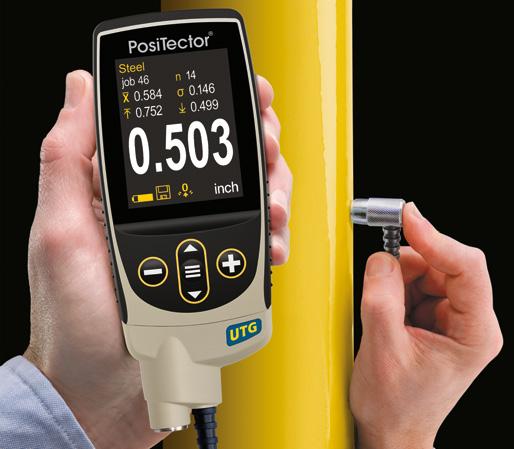


+1-315-393-4450 n 1-800-448-3835 techsale@defelsko.com n www.defelsko.com





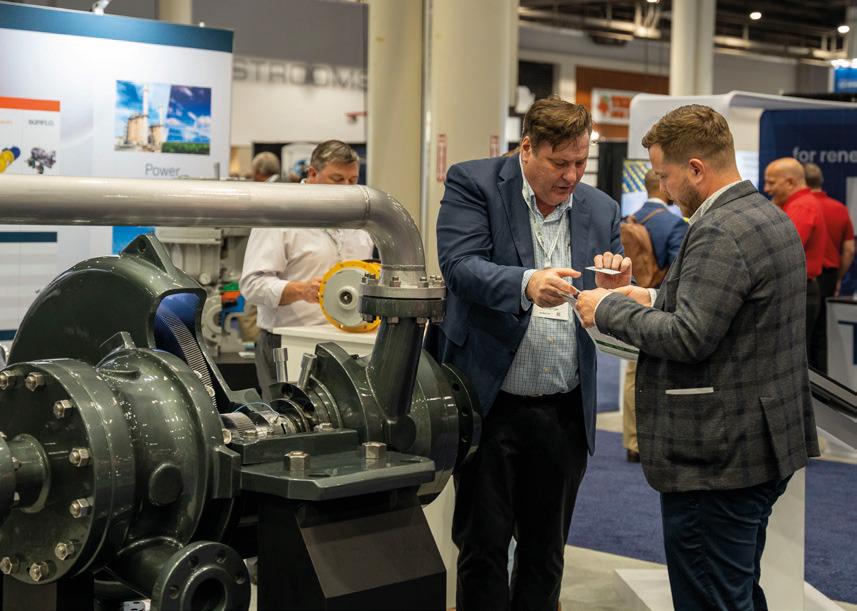



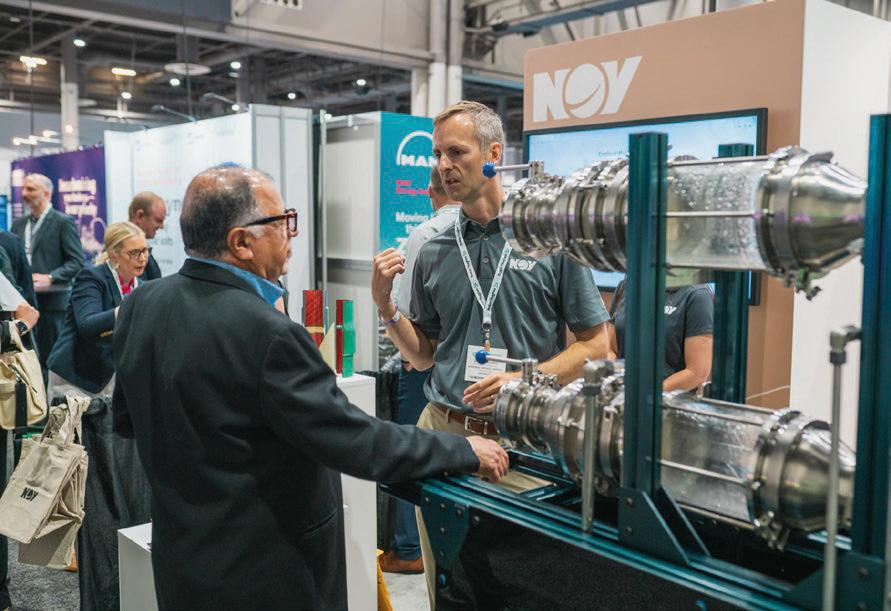

low assurance is the lifeline of offshore and subsea oil and gas operations, ensuring the smooth and uninterrupted transportation of hydrocarbons from reservoirs to processing facilities. This seemingly simple task becomes more challenging in deepwater and ultra-deepwater environments, where high pressures, low temperatures, and long pipeline distances create fertile grounds for blockages caused by hydrates, asphaltenes, wax, and scale. Operators must redefine how they identify, address, and prevent flow assurance challenges in this high-stakes field.
The industry is changing, driven by ageing assets, technological advancements, evolving industry demands, environmental concerns and regulatory pressures. Embracing and preparing for this change is essential, and rapid receipt of accurate data is as crucial as ever, as maintaining flow is essential for operational success.
Advanced diagnostic and measurement solutions are required to ensure the efficient and uninterrupted flow of hydrocarbons in pipelines, wells, and processing systems.
Jim Bramlett, Commercial Manager – The Americas, Tracerco, explores how the technology, sustainability, and efficiency shaping the energy sector as a whole are reflected by changes in flow assurance.


A pipeline sitting 9000 ft below sea level has immense pressure, and not all tools can operate at those depths. Wells are changing – they are getting hotter and have increased pressure – and the way a company operates them has to change in accordance. It may be that more chemicals are needed to prevent an issue, but this can only be planned for if the necessary insights have been gathered.
As assets are ageing and the life of fields are decreasing, companies are using longer subsea tiebacks to maximise recovery from distant fields while reducing the need for new infrastructure. This lowers costs and extends the life of existing facilities, but it’s a longer run, and a flow assurance issue in a longer subsea tieback can disrupt hydrocarbon flow, leading to blockages such as hydrate or wax formation, increased downtime and costly remediation efforts. Put simply, operators can’t fix what they can’t find.
An operator we worked with in the North Sea had a suspected blockage in a 6 in. flexible riser to a semi-submersible production platform and needed to obtain information on the location. After evaluating a variety of pipeline inspection technologies, the North Sea operator decided to deploy Tracerco’s non-intrusive screening technology, ExplorerTM
The technology works by scanning pipelines through any type of coating to obtain a mean density profile along the pipeline. The results confirmed a full-bore blockage of the Naturally Occurring Radioactive Material (NORM) scale in the loop leading up to the mid-water arch.
This information allowed the operator to commence remediation activities with confidence. Typically, 50 - 80% of remediation attempts fail the first time, and further attempts double the associated cost. Therefore, an operator needs to determine the exact nature of a flow assurance issue before wasting resources. With our insights, operators can get it right the first time, increasing efficiency and reducing operational costs and production downtime caused by ineffective remediation.
The industry faces increasing pressure to reduce its carbon footprint and be sustainable. As a result, chemical usage for flow assurance is being optimised to minimise environmental impact. Companies can reduce the risk of environmental issues and ensure environmental compliance during pipeline commissioning and decommissioning projects by obtaining a full picture of the pipeline’s contents and condition at the earliest stages.
Historically, flow assurance relied heavily on modelling or reactive methods to address problems like hydrate formation, asphaltene, wax deposition or scaling after they occurred. A proactive approach is now essential, using advanced analytics to predict and mitigate issues before they impact operations.
To support customers in visualising the condition of subsea pipelines, Tracerco developed the DiscoveryTM CT scanner to proactively see integrity flaws of piggable and unpiggable subsea pipelines in real-time. Baseline scanning is carried out right after operations begin, followed by periodic scans to identify any buildup before it becomes a bigger and more expensive issue for companies. This non-intrusive, field-proven diagnostic technology is designed to address challenges related to flow assurance, such as blockages,
deposits and flow restrictions within pipelines and subsea flowlines, delivering real-time insights.
We were recently contacted by an operator in the Gulf of Mexico as a pipeline was blocked during start up after a planned platform turn around. After several unsuccessful attempts, the operator couldn’t remediate the line, suggesting that more information on the location, size and nature of the blockage was needed. We conducted an inspection campaign to locate and measure the size of the deposit and fully characterise the type of blockage in the line. Explorer was deployed first by the operator to measure the mean density of the pipeline contents. Once it had confirmed where the pipeline sections with the largest deposit were, Discovery was used to characterise the pipeline contents at each of the specified locations.
The operator’s feedback was that in just ten minutes of scanning, Discovery had shown the company more about the pipeline’s condition than all the modelling that had been carried out in the two years prior. It again proved the real benefits that could have been achieved if more detailed insights had been gathered before the start-up.
It is critical that businesses invest in predictive maintenance. Blockages can be caused by multiple issues, such as changes in the well dynamic. It could be a change in pressure, a change in fluid composition, or they may be producing more water. Maintaining uninterrupted flow and minimising downtime is essential to the financial success of a project, with operators facing significant production downtime when flow is disrupted.
The technology exists to support operators with this challenge, identifying deposition build-up issues well before it becomes a critical issue. Committing budget up-front for predictive maintenance is significantly more cost-effective than dealing with the issue after it has happened. We have customers who have experienced total blockages in the past and now engage in predictive maintenance every time, because of the cost implications they previously incurred. Looking to alleviate the issue before it even exists can help save owners and operators tens to hundreds of millions of dollars.
This approach also increases safety for the workforce, reducing the likelihood of pipeline failures by identifying issues early, mitigating potential environmental and safety hazards. Platforms are designed with specific flow rates in mind and any reduction or halt in flow to the platform can alter its operating dynamics and lead to changes in pressure, temperature and system stability, potentially increasing the risk of equipment failure or hazardous conditions. Non-intrusive inspection tools also ensure there’s no need for personnel to handle hazardous materials or work in high-risk environments like confined spaces.
The changing flow assurance industry reflects a broader evolution in energy production, with technology, sustainability and efficiency shaping its future. To remain profitable, companies must adopt new technologies, rethink traditional approaches to stay competitive and embrace a proactive approach to ensuring flow assurance.



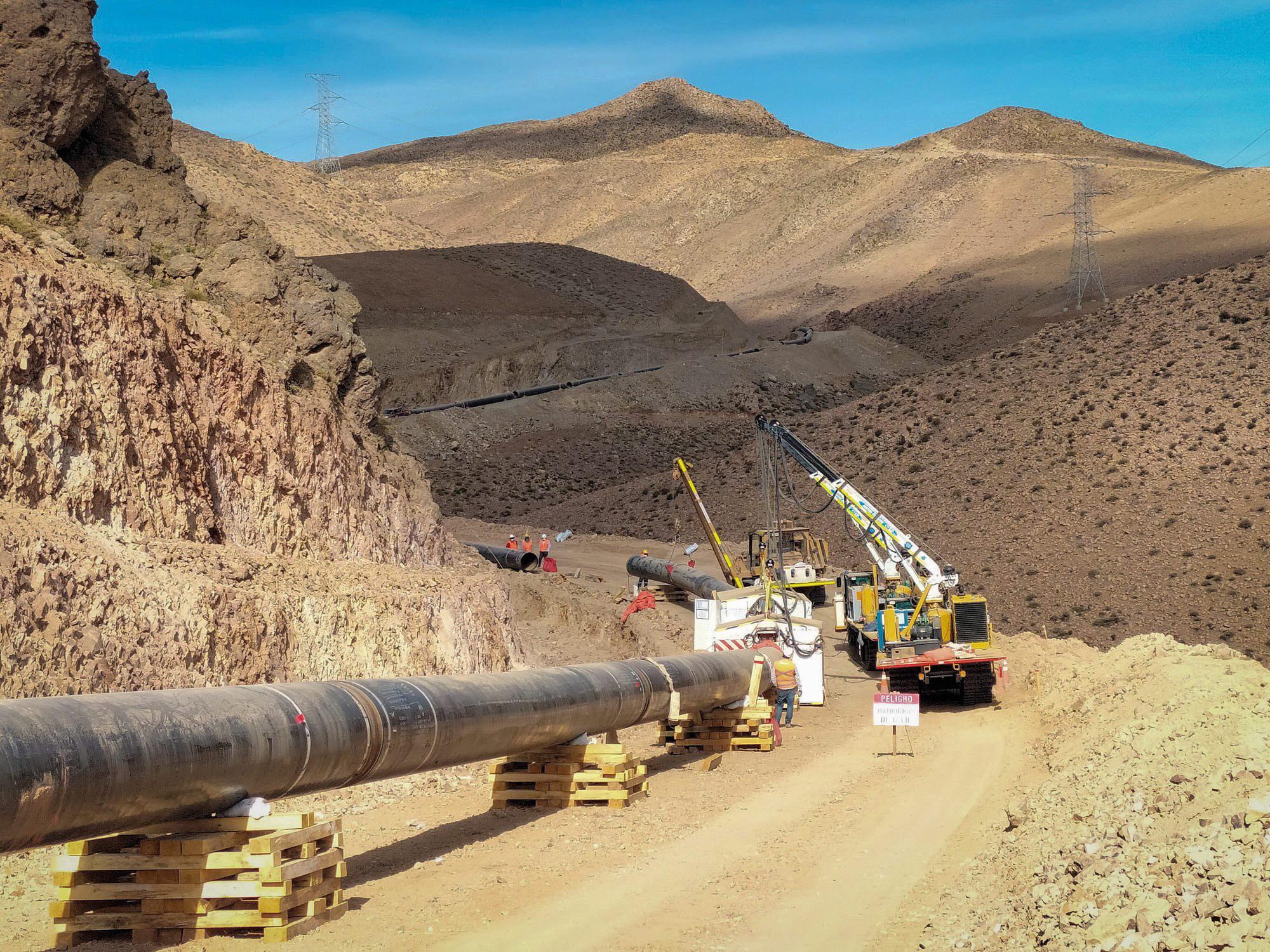
The facts are stark. NACE (AMPP) Impact Study revealed the annual global cost of corrosion across all sectors is more than US$2.5 trillion. And when it comes to the oil and gas industry, corrosion under insulation (CUI) accounts for up to 60% of pipeline failures.
Asset integrity is a huge issue for the industry, given there are sufficient oil and gas pipelines to circle the world 30 times. The sheer volume of surfaces to inspect and maintain can be overwhelming. Especially when so many are hard to access.
CUI continues to be one of the biggest challenges for the oil, gas and petrochemical industry to overcome. Organisations must insulate their assets to protect them against temperature
extremes, preventing damage and expanding their life. But when this extra layer fails, moisture ingress is more likely to happen. Trapped out of sight, CUI can then develop, often unpredictably.
CUI can cause untold damage. Without keeping on top of it you’re at risk of costly downtime, either from leaks, or the need for costly (and urgent) repairs.
For decades, the answer has been to manually inspect asset surfaces on a regular basis to spot visual signs of CUI. No small task when you’re a global operator.
As we journey through the Industry 4.0 era, which embraces the industrial internet of things (IIoT), advanced technology

Dr Prafull Sharma,
Chief Technology Officer, CorrosionRADAR,
considers the benefits of remote predictive monitoring solutions for pipeline corrosion under insulation (CUI) in comparison to traditional manual inspection.
offers new ways to mitigate against CUI. One concerns remote predictive monitoring, and several leading organisations have spoken of the benefits.
So, how does remote, predictive monitoring compare to traditional manual inspection? That’s the purpose of this article.
When considering which method contributes the most to asset integrity, you must consider several factors. This article will touch on the following areas:
) Asset management: which method helps manage your asset’s service life better by catching problems early to reduce maintenance costs?
) Associated costs: how does each method compare in terms of the associated costs from using it?
) Insight: which method gives you the best insight on asset condition and expected service life?
) Safety of personnel: what safety issues exist with each method, and which one is safer for your employees and contractors?
) Environmental protection: how does each method impact the environment, or heighten risk for it?
) Company reputation: what risk does each method pose for your company’s reputation?
Table 1. Key points to consider between manual CUI inspection and remote, predictive CUI monitoring
Manual CUI inspection
Asset management
At most, you’re likely to inspect 50% of your assets. As CUI is unpredictable, how do you know you’re checking the right locations?
Associated costs
Data insight
Safety of personnel
Widespread manual inspection requires extensive scaffolding and team resources. Annual costs can easily amount to a few hundred thousand dollars.
You only have insight on the locations you manually inspect. The rest is totally unknown to you.
Working extensively in the field, at height and in extreme temperatures, increases safety risks for employees and contractors.
Environmental safety
Several factors will be highlighted below, to provide a meaningful comparison between manual CUI inspection and remote, predictive CUI monitoring.
Manual CUI inspection will be a familiar method. The process involves removing vast swathes of insulation on assets and pipelines to physically check for signs of deterioration on the metal. It’s been the most commonly used method for decades.
Many global standards exist to guide organisations on the extent and frequency of manual inspections. For example, API 570 recommends the interval should be every few years, five to ten years or more, advising companies to inspect up to 50% of susceptible locations and up to 75% of damaged areas. In some cases, it suggests up to 100% of susceptible areas.
One problem with this approach is scale. 50% is an ambitious target for even the smallest operator. And which 50% do you inspect? CUI can be unpredictable – moisture can ingress where you least expect it. Of course, you can prioritise common risk areas such as assets used for cyclic or intermittent service. Carbon steel can corrode several times faster under insulation. But aside from these situations, educated guesswork often determines where to inspect.
Company reputation
Without insight, you can’t spot the highest risks early enough to prevent extensive repairs or a leak. Nasty surprises can occur at locations you haven’t inspected.
Pipeline failures can cause bad press. No organisation wants to be associated with costly operational failures and environmental disasters.
Remote, predictive CUI monitoring
With sufficient sensors, you have 24/7 data on all your critical assets without needing to physically inspect them.
Upfront investment in the latest technology helps mitigate your CUI risks for years and significantly reduces your manual inspection and repair bills.
You have timely, 24/7 data insight on all assets monitored. Served via a user-friendly dashboard that helps asset managers accurately identify and predict rates of deterioration.
Removing routine inspection activity in the field makes your CUI management process safer for employees and contractors.
By spotting CUI early, or predicting where it may happen before it does, you can repair deterioration with minimal interruption to production.
Stakeholders will welcome a more effective CUI management process, and your organisation will be less likely to suffer bad press from unexpected failures.
Accessibility can also be a challenge. Some of the most at-risk assets may be in hard-to-reach locations and require extensive scaffolding and other access methods. It’s easy to see how scale, coupled with accessibility headaches, can ramp up inspection costs to hundreds of thousands of dollars annually. And you still don’t know what risks the noninspected 50% poses.
When it comes to safety, having a substantial inspection team in the field (often at height) increases risk. They must manage their physical safety while also working at speed to deliver the productivity expected of them. It’s a tough working life, especially in climates that may be extremely hot and arid or cold and icy. So, manual inspection is a straightforward method, but it comes with operational costs, and risks to personal safety. Also, it only provides insight on the assets you’re inspecting. How do you know the biggest risks aren’t developing below insulation you’ve yet to uncover?
And that’s the gamble. Not only are you risking an unexpected repair bill or unproductive downtime you’re potentially risking your reputation should a pipeline failure occur. Pipeline failures damage the environment too, so asset integrity teams want to mitigate the risk of this happening. It’s costly in terms of repair, but also due to environmental harm, and once again, your company’s reputation.
This method of managing CUI risk has rapidly evolved due to the advance of Industry 4.0, remote sensor technology, and AI. In all industrial sectors, technology is transforming how we work and offering new ways to be more effective. When you use remote monitoring, you can ensure less of your assets are at risk of having undetected damage from CUI without increasing your annual inspection budget. By attaching connected devices to your assets, you collect 24/7 data wirelessly, without physical inspection.
We are running out of space...

Our inventory in sales & rental in pipeline equipment is out of this world. We have a huge amount of machines from all the big brands that are ready for worldwide delivery, or even further if you want...
You can build on BAUMA!
This timely insight then helps to assess (and predict) where the highest CUI risk areas are. Data-informed, you make targeted decisions about where to send your asset maintenance team, so they catch problems early.
In other words, by spotting potential failures before they occur, both maintenance costs and downtime risks fall significantly. Asset integrity engineers can focus their resources on the highest priorities and lessen the risk of CUI catching them out unawares.
Remote monitoring therefore makes CUI more predictable. When you can accurately predict the location and rate of deterioration your inspection and repair schedule become
laser-focused and more effective. And while remote monitoring doesn’t eliminate manual inspection, it ensures you are inspecting the right areas at the right time. In short, remote monitoring eliminates nasty surprises. Armed with remote data, asset managers can establish a dynamic approach to CUI risk assessment, predicting corrosion rates accurately and responding to problems early.
So, remote monitoring is more effective than manual inspection in lessening the CUI risk. The upfront cost of installing the technology is inevitable but consider the bigger picture to see the ROI. The significant reduction in annual inspection costs (due to factors such as excessive scaffolding, resources, and replacement insulation), lower repair costs (from catching problems early), and lower risk of an unexpected failure justify the investment.
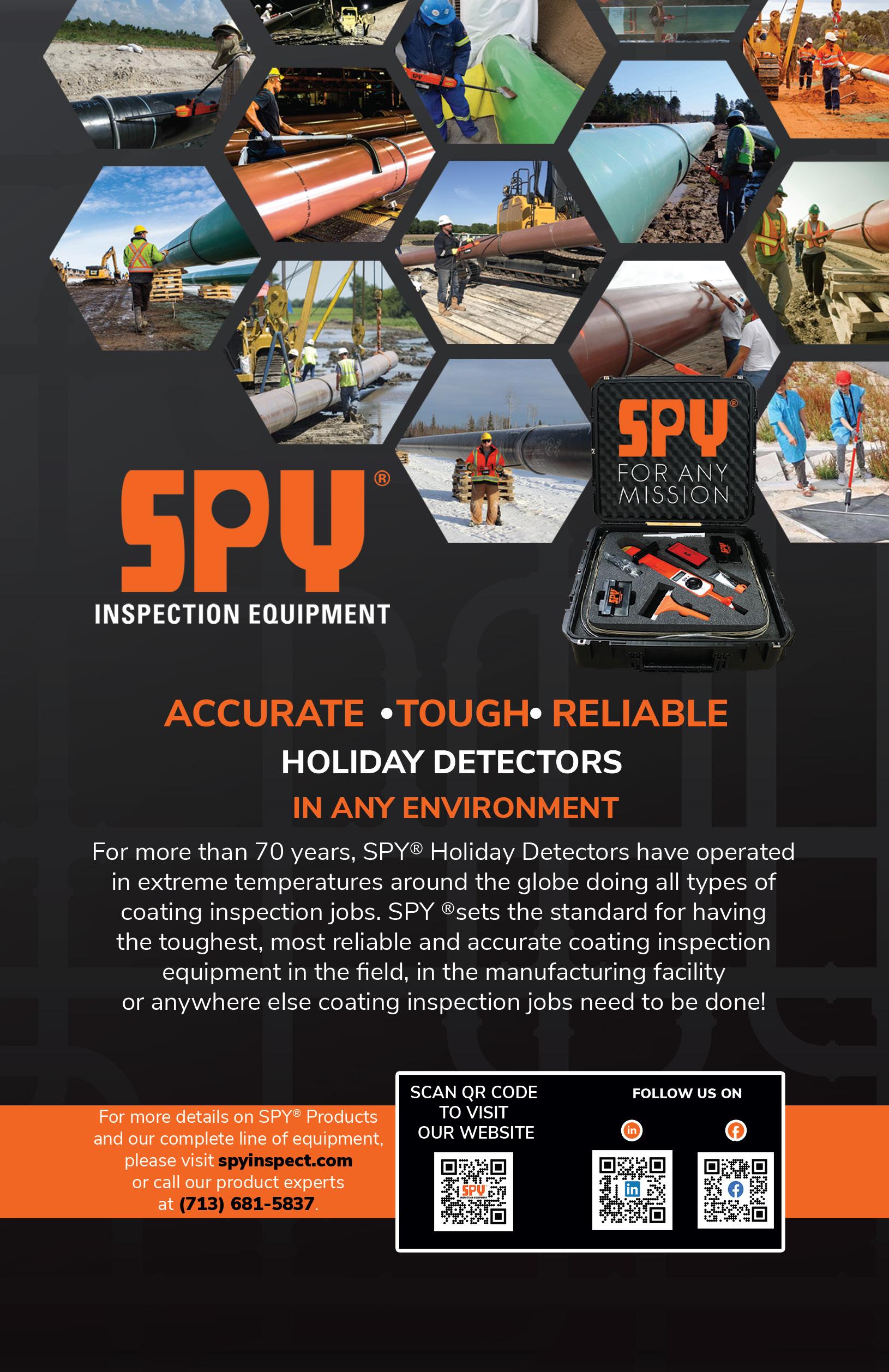
As for personnel safety, remote monitoring eliminates routine inspections in the field. Instead, maintenance teams target areas they know need repair. This is especially welcome in remote locations where asset inspection is time-consuming and dangerous.
Finally, predictive CUI monitoring offers sustainability benefits over manual inspection. By spotting corrosion early, and prioritising repair, maintenance teams can prevent failure and fluid escapes. This reduces the impact of oil and gas production on the environment while enhancing site safety. It also enhances your reputation as a responsible operator.
Is it time to shift to predictive maintenance?
Many oil and gas companies may feel comfortable with the status quo of manual CUI inspection. But they may not realise how technology can manage the risk better. Also, remote CUI monitoring significantly reduces regular inspection costs and maintenance bills. Whichever way you look at it, this is a change that benefits organisations.
Taking the leap can feel daunting. That’s why it’s important to compare where your CU management strategy is now and where you may choose to move it to. By considering both scenarios carefully, you can feel more confident about your decision.



rom the construction of oil and gas wells in extreme conditions to seamless line pipes that address extreme environments with improved tube performance, enhanced weldability, and better resistance to corrosion, as well as solutions for the hydrogen, carbon capture, utilisation, and storage (CCUS) and geothermal markets, Vallourec is at the heart of the 21st century’s energy challenges.
Vallourec leverages its expertise in metallurgy – applied to the most demanding environments and extreme conditions such as corrosion, high
Nora Brahmi, New Energies & Project Line Pipe Marketing & Development Director, and Corinne Willecomme, Sustainable Development Group Director, Vallourec, discuss how tubular products providers are adapting to recent developments in the new energy sector.

pressure, and high temperatures – to deliver premium tubular solutions, particularly for the energy sector. Vallourec has an annual worldwide production capacity of 1.3 million t of tubular products. In corrosive environments, where materials face intense chemical, thermal, or mechanical stress, the reliability and durability of tubes are critical.
Backed by decades of state-of-the-art R&D and partnerships with the most demanding industries, the company develops tailor-made steel grades and applies specialised heat treatments and protective coatings to meet every operational challenge. This legacy and expertise enhance the safety, performance, and lifespan of critical infrastructure across key sectors, including the oil and gas industry and new energies.
Building on its long-standing expertise, Vallourec operates in the oil and gas industry alongside leading players, from exploration and production to the transport and processing of oil and gas. The group provides seamless line pipes for offshore & onshore applications, solutions for ultra-deep and sour service environments and digital solutions to optimise line pipe operations.
Since 2019, Vallourec has also developed innovative solutions for new energies markets. By expanding its portfolio to include hydrogen, CCUS and geothermal energy, Vallourec has established itself as a key player in the decarbonised energy sector.
What makes this strategic shift particularly significant is a unique ability to deliver solutions that can withstand even the most corrosive environments, sometimes also facing challenges regarding high temperature and pressure. Mastering all operational conditions and providing mission-critical tubes and connections is a defining characteristic of Vallourec’s DNA.


With technologies engineered to withstand even the harshest conditions, Vallourec significantly enhances the safety of new energy sector technologies. The group has played a key role in testing and qualifying corrosion-resistant materials for transporting CO 2 This expertise is critical, as corrosion presents a major challenge for the entire industry – particularly in environments containing hydrogen sulfide (H 2 S), a toxic and explosive gas that requires specialised materials to prevent tube cracking.
It is crucial that companies storing and transporting captured carbon pay careful attention to the choice of pipelines used, ensuring they resist corrosion. The presence of impurities such as hydrogen sulfide, NOx, SOx or Oxygen that comes from industrial sources of CO 2 can lead to severe corrosive conditions. Vallourec’s research and testing programs have enabled it to develop specific material solutions that ensure safety and longevity in these challenging environments.
Vallourec has demonstrated its ability to deliver tailored solutions for any environment. This safety guarantee is backed by rigorous,


field-proven testing across all new energy sectors, including CCS and hydrogen. Each of Vallourec’s solutions is designed to meet the demands of all types of operations, from conventional wells to the most extreme conditions. The company offers a broad portfolio of high-performance steel grades, tested and validated in every environment.
) For carbon capture and storage (CCS), Vallourec’s experts have developed secure, leak-proof transportation pipelines that can withstand a range of different pressure and temperature levels – key to the success of CCUS. These high-standard pipelines address extreme environments and provide improved tube performance, enhanced weldability, and better resistance to corrosion. Vallourec has secured an order to supply 2800 t of line pipes for a major CCS project in Wyoming. This ambitious project required several specifications, including the need for a fully integrated package (uncommon in the US market), line pipes with anti-corrosion properties to withstand the corrosive environments, and specialised induction bends, adding complexity to the design and installation.
) For hydrogen-related applications, Vallourec designs tubes that undergo specialised treatments to mitigate the risk of embrittlement caused by hydrogen diffusion, a phenomenon that can compromise material integrity over time. With its cutting-edge tubular solutions, the group supports its clients in hydrogen transportation via pipelines, as well as hydrogen storage, particularly underground storage in salt caverns. In 2023, Vallourec developed Delphy, the world’s first vertical hydrogen storage solution, and inaugurated its onsite demonstrator in Northern France. Delphy consists of an underground system capable of storing up to 100 t of gaseous hydrogen under maximum safety conditions. The system is designed for green hydrogen producers and users for industrial applications and heavy mobility. Delphy enables users to streamline their costs and offer high supply safety levels.
) Offshore and deepwater environments impose specific requirements in terms of robustness and longevity, and Vallourec delivers solutions designed to withstand extended life cycles. In July 2023, Vallourec won two major orders to supply line pipes for phases 6 and 8 of the Buzios oil field development operated by Petrobras. Located off the Brazilian coast in the presalt Campos Basin, Buzios is one of the world’s largest deepwater fields. It accounts for 25% of the Brazilian oil company’s production alone. The equipment ordered from Vallourec for phases 6, 7 and 8 of the project includes 346 km of subsea line pipe for the risers and flowlines in the Subsea Umbilicals Risers and Flowlines (SURF) package. These ultra-premium line pipes will be mechanically lined pipes (MLPs) with CRA (Corrosion Resistant Alloy) cladding.
) Finally, in the field of geothermal energy, Vallourec’s tubes offer exceptional resistance to high temperatures
and fluid acidity, ensuring optimal durability in extreme environments.
Responsible production with a low carbon footprint
By developing activities in new energies, Vallourec has not only provided the sector with robust solutions but has also embraced more sustainable materials, using steel primarily made from recycled scrap metal and biomass charcoal. The results are significant: in 2023, the Group’s carbon footprint reached 1.45 t of CO 2 e/t of tube produced, marking a 19% reduction in just four years compared to 1.79 t recorded in 2019.
By integrating recycling at the core of its production and prioritising low-carbon energy sources, Vallourec is attempting to strengthen its role as a key player in the energy transition. This approach aims to meet the market’s growing demands while paving the way for a more sustainable future for the industry – innovation and environmental responsibility can go hand in hand. Reducing the Group’s carbon footprint is the result of a proactive strategy and the unwavering commitment of Vallourec’s teams.
This low carbon footprint is recognised and certified. Vallourec’s efforts have been validated by the independent institute EPD International AB, a subsidiary of the IVL Swedish Environmental Research Institute. The approach used for the calculations is ‘Cradle to Gate’, including in particular upstream processes for the supply of raw material and steel billets, as well as core processes for the internal manufacturing of tubes.
This certification serves as proof of transparency and performance in reducing carbon footprint. It is based on a detailed and quantified life cycle assessment of a company’s products, covering all production stages – from raw material extraction to distribution.
The reductions that led to this certification were achieved through multiple strategic levers and choices. First, 61% of the steel used by Vallourec now comes from recycled scrap, reducing natural resource consumption and associated emissions while promoting a circular and sustainable approach. More broadly, all Vallourec entities are engaged in this effort, prioritising low-carbon electricity. The group’s US steel mill is an example: it operates with 98% recycled scrap and 100% low-carbon electricity. Overall, 90% of the electricity consumed by Vallourec comes from renewable or nuclear sources, significantly lowering CO 2 e emissions.
In Brazil, Vallourec leverages a unique asset: its own eucalyptus forests, which produce biomass charcoal used as a substitute for coke in its Jeceaba blast furnace. This process significantly reduces CO 2 e emissions and ensures a more sustainable production model. Besides, all Vallourec’s production sites are ISO 14001 (Environmental) certified. By committing to further progress, Vallourec aims to reduce its carbon footprint by 35% by 2035 compared to 2021.
When your pipeline shares a right of way with high-voltage power lines, the electromagnetic field on the power lines can induce unwanted voltage onto the pipeline, creating a safety hazard for personnel and contributing to AC corrosion problems. Dairyland decouplers provide an effective grounding path that mitigates induced AC, while simultaneously maintaining DC isolation to optimize your CP system. With a Dairyland decoupler, your CP system will continue to work efficiently, and the pipeline and personnel will be safe from AC interference.

Let us help you find the right solution for your AC Mitigation problems.

Meghan Connors, President, PipeSak® Incorporated & PipeSak® USA, Inc., describes how the next generation of rockshields are improving pipeline coating protection as well as providing faster installation times.

s demand for oil and gas increases, so do the pipeline diameters needed to transport it, requiring deeper trench excavations. As trenches get deeper, the occurrence of rock and stone in the soil increases. Damage to pipeline coatings, whether during installation or throughout their operational lifespan, can lead to costly repairs and compromised performance and safety.
The largest risk to long-term pipeline integrity is corrosion. To protect steel pipelines from corrosion, a two-fold system is used. First, the pipelines are coated, often with a fusion bond epoxy (FBE) or comparable coatings, to protect them from the elements and prevent long-term corrosion. As additional protection, an electrical anti-corrosion system is installed, called a cathodic protection (CP) system, which protects the pipe by reversing the corrosion process in the event the coating is ever damaged. Protecting pipe coatings from damage during construction is paramount to mitigating the risk of corrosion, particularly in areas of rock and stone. Not only can sharp rocks damage the coating, they can also restrict the flow of electrical currents needed for the cathodic protection system to be effective. Depending on the size and type of rock encountered during construction, different methods of pipeline protection are used such as thin film concrete coatings or rockshields, typically in combination with sand padding.
Rockshields, which are wrapped around the pipe in the field prior to lowering in the trench, are often the most economical and flexible method used to protect pipeline coatings in areas where smaller rocks and stones (< 6 in./152 mm) are present. Over the years, several types of rockshield have been developed and brought to market with varying degrees of success. Traditionally, the most commonly used rockshield styles include:
Stranded rockshields are manufactured by melting and extruding flexible polymers, most commonly polyvinyl chloride (PVC) with

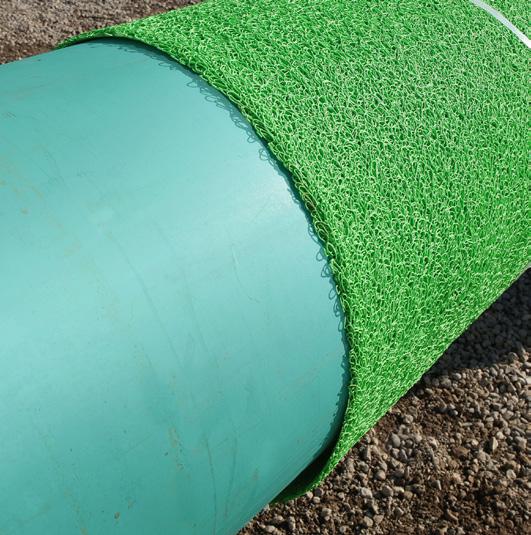

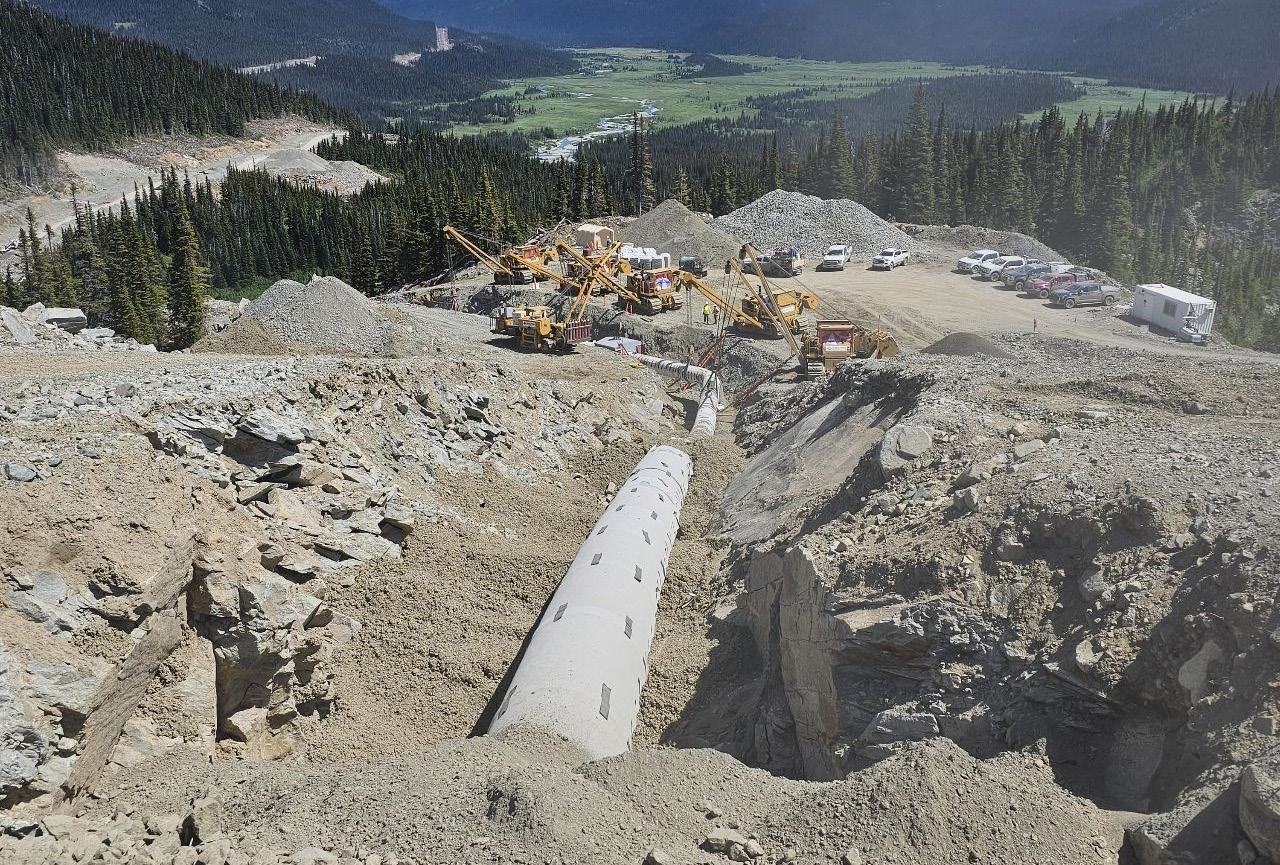
additives such as blowing agents and fillers, into a randomised, spaghetti-like pattern. Once referred to as the ‘gold standard’ in rockshields, stranded PVC is typically the most expensive option, both in initial purchase cost and installation costs. This is mainly due to the weight of the product – stranded rockshields are heavy, resulting in higher material and transportation costs. They are also cumbersome to install, requiring several labourers to wrap them around the pipe and spiral tape it to hold them in place.
Grid patterned rockshields have gained market share over the past several years mostly due to the low cost of manufacture. They are typically extruded from high density polyethylene (HDPE) with a higher concentration of blowing agents to ‘foam’ the plastic, resulting in a lighter weight finished product. While grid patterned rockshields are lighter, reducing initial purchase and transportation costs, they are still cumbersome to install. In cold weather conditions they may become stiff and difficult to handle, slowing down installation.
It is critical that rockshields, or anything that is in long-term contact with the pipe, do not impede cathodic protection systems. Traditional stranded and grid-type rockshields achieve this by allowing the electrical currents of the CP system to pass through void spaces – small openings in the material where pipe is exposed (Figure 1). This is most pronounced in grid-patterned rockshields where evenly distributed holes could allow sharp, angular rocks to damage the coating. Smaller rocks have also been known to get stuck between the rockshield and the pipe, raising the risk of scouring the coating. Stranded rockshields offer slightly better protection due to their randomised, overlapping design, but the risk of rocks penetrating the void spaces is still there. Recognising this risk, some companies have started affixing a thin, needle punch fabric to the underside of the rockshield. While this may help prevent small rocks from working their way between the rockshield and the pipe coating, it offers no additional impact protection against sharp, angular rocks.
Rockshields are applied in the field by workers prior to the lowering in process. Rockshields for small diameter pipelines, under 24 in. (610 mm) outer diameter (OD), are usually supplied in 30 - 50 ft (9 – 15 m) rolls, which are walked down the pipe and either cigarette or spiral-wrapped. Rockshield for larger OD pipelines is usually supplied as pads that are wrapped around the pipe, one at a time, and overlapped. Traditional rockshields are affixed to the pipe by spiral-wrapping tape – a time consuming and tedious process often requiring workers on either side of the pipe (Figure 2). In pipeline construction, time is money – the longer it takes to install, the higher the labour costs.
A top concern on any pipeline construction project is worker safety. When a pipe is strung out along the right or way, the workers are supposed to remain on the work side of the pipe
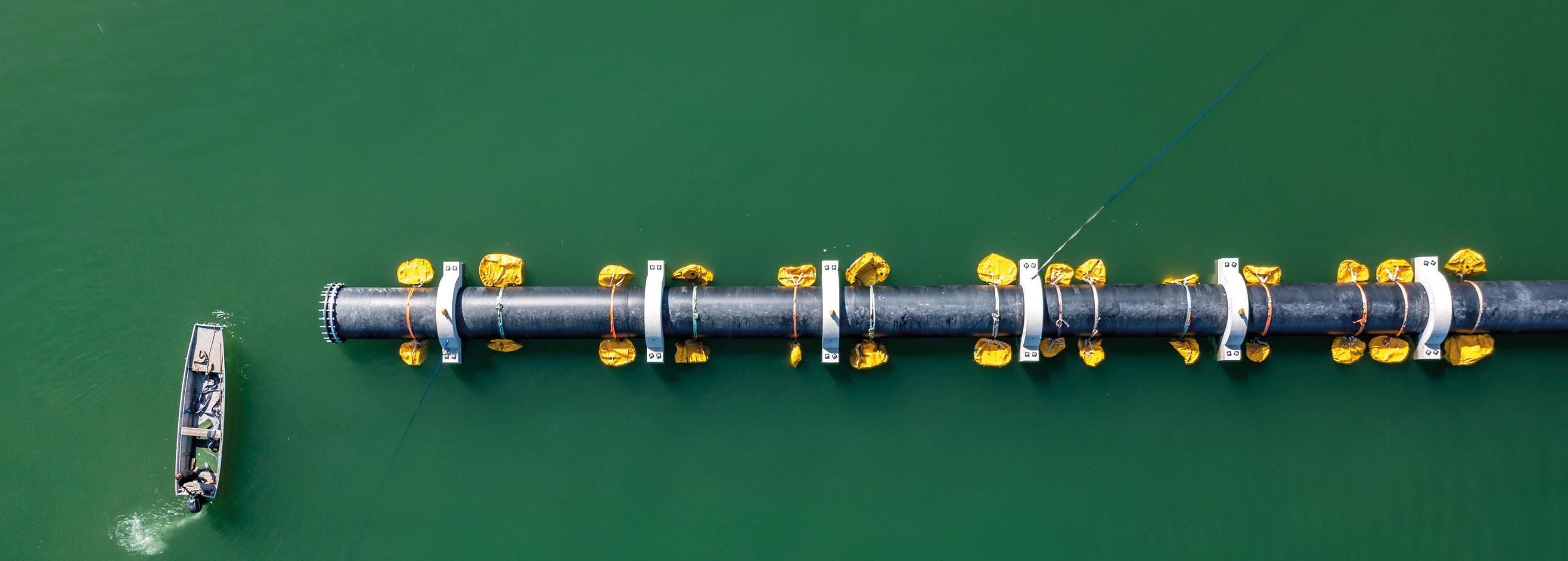
HDPE piping systems for intakes & outfalls
• OUTSTANDING LIFE SPAN
• FAST AND EASY INSTALLATION
• FOR HIGH-VOLUME FLOWS
• HIGH-QUALITY MATERIALS
• EXPERTISE IN PLASTICS PROCESSING
agru Kunststofftechnik Gesellschaft m.b.H.
Ing.-Pesendorfer-Strasse 31 | A-4540 Bad Hall T. +43 7258 7900 | office@agru.at | www.agru.at
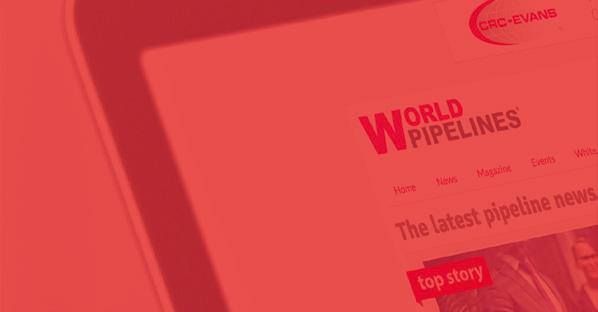





– away from the trench. When installing traditional rockshields, particularly on large OD pipelines, this is often impossible. At least one worker needs to be ditch-side, with their back to the trench, in order to affix the tape – increasing the risk of a workplace accident.
Next generation rockshields
In the past, PipeSak manufactured and marketing a stranded rockshield called PipeJacket®. While the random strand design of PipeJacket and similar rockshields is superior to a grid pattern



design, there had to be something better. PipeSak engineers set out to develop a new style of rockshield that addressed the concerns of both the engineers designing pipelines, and the contractors building them.
After extensive R&D, laboratory testing and field trials, PipeSak launched RockStop® Pipeline Protection wrap. RockStop rockshield is a lightweight non-woven geotextile made of a proprietary blend of fibres that offers best in class, 360˚ impact, puncture and abrasion protection. It works with cathodic protection systems, and installs in a fraction of the time as traditional rockshields. RockStop rockshield can be safely installed with the Velcro-like QuikStrip® fasteners or permanently sealed using Pipesak low temp Heat Tool.
RockStop rockshield outperforms any other field applied rockshield on the market, protecting large OD pipe from up to 8 in. (203 mm) rock impacts dropped from a height of 6 ft. (1.83 m).
Extensive third-party testing in ASTM certified facilities has proven RockStop rockshield to be superior in every category including impact strength, puncture strength and abrasion resistance. RockStop rockshield does not inhibit cathodic protection systems and remains flexible to temperatures as low as -65˚F (-54˚C).
RockStop rockshield was specifically designed to prevent impact and puncture-related corrosion with an engineered interlocking proprietary blend of fibres that still allow the movement of groundwater to and from the pipeline surface for cathodic protection systems. RockStop rockshield has a permeability similar to a clean sand, ensuring water will drain from RockStop rockshield as it does from sand padding or sandy backfill.
The real advantage of RockStop rockshield is the installation. It was designed with contractors in mind – it is faster, safer, and more economical then traditional rockshields.
A controlled field trial on a 48 in. (1219 mm) OD pipe comparing RockStop rockshield installation methods with standard spiral tape installation showed that RockStop rockshield can be installed three times faster than traditional rockshields. RockStop rockshield offers two methods of installation:
) QuikStrip® fastners: QuikStrip fasteners are nylon strips with polypropylene hooks specifically designed for use with RockStop rockshield and are supplied pre-cut in 8 - 12 in. (203 mm – 305 mm) lengths. QuikStrip fasteners have extreme shear and peel strength and are strong enough to be used with rolling cradles – but can be easily removed if required.
) RockStop LT Heat Tool: RockStop rockshield is designed with a proprietary fibre composition that allows it to be heat-sealed using our low temperature heat tool to create a permanent seal (Figure 5). RockStop rockshield adheres to itself permanently in seconds, dramatically decreasing installation time. When heat sealed, RockStop rockshield will continue protecting the pipe coating for the life of the pipeline, a major benefit in areas prone to ground movement or floods.


One of the biggest complaints heard from installation crews on the right-of-way is the difficulty handling traditional rockshields. Stranded rockshields can be heavy and awkward to install and, without expensive additives, can become brittle in extreme cold. Grid-type extruded rockshields are known to be sharp and rough on the hands and can become stiff and difficult to wrap around the pipe in cold weather conditions. RockStop rockshield was designed for the -22°F (-30°C) weather of the Rocky Mountains. It remains lightweight and flexible in all weather conditions.
RockStop rockshield is up to 50% lighter than traditional stranded rockshields and is manufactured from fine poly fibres ensuring it is always flexible and soft on the hands. It can be installed with less workers and, most importantly, with no worker ditch-side. With RockStop rockshield’s lightweight design, the contractor will realise savings on labour and efficiency, as well as being more economical to manufacture, transport, and handle compared to other rockshields on the market.
The Coastal GasLink pipeline project is approximately 416 miles (670 km) of 48 in. (1219 mm) OD pipe traversing some of the most challenging terrain in Western Canada. The pipeline transports 2.1 billion ft3/d of natural gas across northern British Columbia to the LNG Canada facility in Kitimat for export to global markets. The CGL pipeline route not only traversed rocky terrain but the Rocky Mountains themselves – it was arguably the most challenging pipeline construction project in Canadian
history. RockStop rockshield was used extensively during the three year construction project, along with PipeDefender® engineered pipeline lagging and PipePillo® pipe stands, to provide 360° of pipeline protection. The RockStop rockshield adheres especially securely to the pipe when using QuikStrip fasteners for installation. The contractor was able to move protected pipe using slings, rolling cradles, and even cranes with no risk of the RockStop rockshield shifting (Figure 6).
The Regional Energy Access Project increased natural gas capacity by 829 400 million ft3/d along Transco’s existing transmission system, which transports Marcellus shale gas to customers in Pennsylvania, New Jersey and Maryland. The project involved constructing two pipeline loops running parallel to the existing Transco System in Pennsylvania including 22.3 miles (35.9 km) of 30 in. (762 mm) OD pipeline (Regional Energy Lateral) and 13.8 miles (22 km) of 42 in. (1067 mm) OD pipeline (Effort Loop). RockStop rockshield was used to protect 18 miles (29 km) of the 30 in. (762 mm) OD line through rocky terrain. The speed of installation and the resulting cost savings was a major benefit for the contractor, who heat sealing the RockStop rockshield using PipeSak’s low-temp heat tool. The contractor was able to install RockStop rockshield in a fraction of the time compared to traditional rockshield installation (Figure 7).
The ETNG System Alignment Program is designed to improve the reliability and affordability of natural gas to regional utilities and power generators by increasing pipeline capacity and adding two new compressor stations across three states. The project kicked off in late 2024 with a planned 16.5 miles (26.5 km) of new 24 in. (610 mm) pipeline running alongside an existing 16 in. (406 mm) pipeline in Tennessee, and 6.5 miles (10.5 km) of 24 in. (610 mm) pipe replacing an existing 8 in. (203.2 mm) line in Viriginia. RockStop rockshield was chosen for use on the project due to the speed of installation, increased worker safety, and mechanical protection properties. The project in still ongoing, but after installing 4 miles (6.4 km) of RockStop rockshield using a combination of QuikStrip fasteners and PipeSak’s low temp heat tool, the contractor has already realised substantial savings in both the initial purchase price and reduced labour costs.

Pipeline projects often encounter diverse geological and environmental challenges. Traditional pipeline rockshields often provide uneven protection and require labour-intensive installation, delaying construction and increasing costs. By combining advanced materials with a user-friendly design, operators can not only permanently protect pipelines from damage but also enhance productivity, efficiency and worker safety during installation.
A podcast series for professionals in the downstream refining, petrochemical and gas processing industries





Alan Gelder, Senior Vice President of Refining, Chemicals and Oil Markets at Wood Mackenzie, provides a review of downstream markets in 2024 and looks ahead to what 2025 may hold for the sector.
Dr Klaus Brun, Global Director of Research & Development, Ebara Elliott Energy, joins us to discuss the progress that is being made towards adapting centrifugal compressors for high-speed hydrogen compression.
Listen and subscribe here




Subscribe online at: www.oilfieldtechnology.com/subscribe


o maximise output on large and complex horizontal directional drilling (HDD) projects, a proactive approach is best – because maxi HDD infrastructure projects often have aggressive timelines for completion. Equipment care includes practicing good maintenance habits and planning for issues before they occur.
The most common cause of premature wear of parts and components is not addressing minor issues before they escalate. HDD maxi crews need to pay attention to HDD maxi rig parts, such as vice dies, sub savers, drill rod threads,

Kelly Beller, Vermeer Corporation, USA, makes the case that operators can boost horizontal directional drilling productivity by paying attention to maxi rig parts.

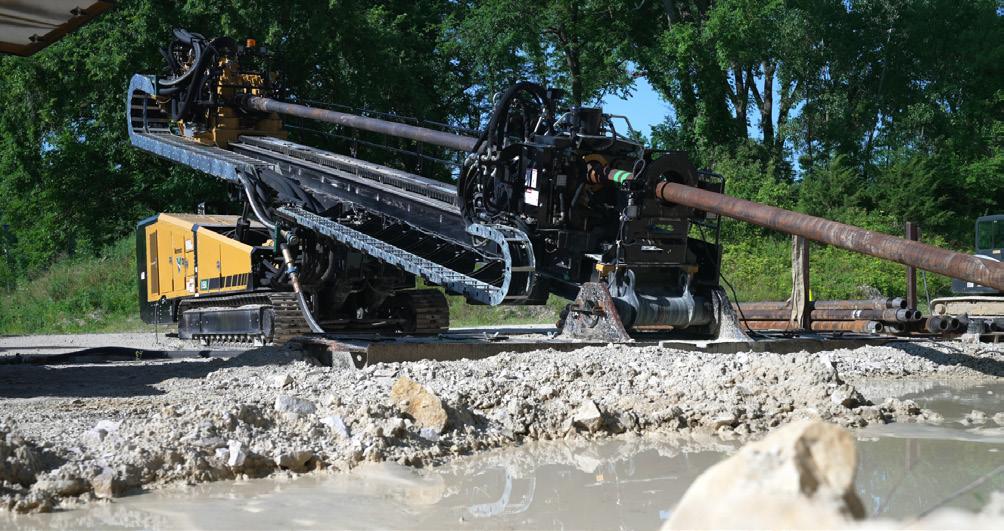
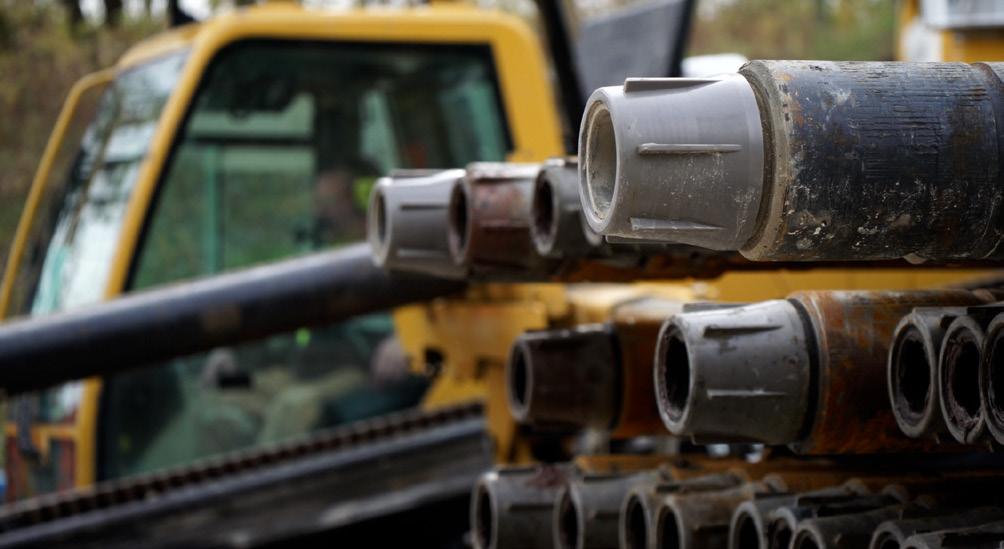

sliding head shafts, gearbox slides, and water swivels. This article details ways crews can care for these wear parts.
The maxi rig’s vice is responsible for torqueing and un-torqueing every drill rod going into the ground. Gripping each connection are vice dies, or vice jaws as some in the HDD industry may refer to them. Vice dies start off with small edges, or teeth, to grip the drill rod when making or breaking a connection. Over time, those edges will wear down and can start to slip when torqueing a connection. An improperly torqued connection can negatively impact the entire drilling operation because it can cause premature wear to other maxi rig parts.
Crews need to keep an eye on the condition of the vice dies. Before starting up for the day, crews should inspect the shape of vice dies. If they are becoming dull and round, it’s time to swap them out.
When vice dies wear too long, rods may start to slip, potentially resulting in premature wear to the threads and the drill’s sub saver. Waiting too long can also make the task of swapping out dies more challenging because they will not slide away from the vice box as easily. And if the dies wear too much, they can eventually damage vice boxes.
Crews should keep their maxi rig’s vice dies clean of debris to get the most life out of them. When it is time to change them, crews should consider investing in an extra set of vice boxes. Trying to slide worn-out dies away from the box on the job can be time consuming, but removing the boxes can be as efficient as spinning out a couple of bolts. Many HDD maxi rig crews will swap out both components on the job. Then, they will swap out the dies on the removed vice boxes back at the shop.
It is vital for crews to keep their sub saver clean of debris to help prevent premature wear. However, excessive debris isn’t the only thing that can impact the operating life of a sub saver. Improperly torqued rod joints, especially when using a tail string, can also adversely affect the conditions of the sub saver. Play in a few joints can cause damage back to the sub saver. It’s a chain reaction. A gap between the shoulders of one connection can cause excessive wear downhole and back to the sub saver. If a crew isn’t getting up to 200 hours of operations consistently from a sub saver, they should look for issues further down on the drill string.
Crews can determine when to replace the sub saver on an HDD maxi rig in the following ways:
Jagged edges or rounded thread profiles indicate that it’s time to swap out sub savers. However, crews shouldn’t just trust their eyes to determine the condition of threads. Instead, they should have a set of thread profile gauges. This will give them a more accurate visual of the sub saver’s condition. Crews should also keep an eye on where the sub saver connects to the drill’s drive chuck. Any play in that joint indicates that the thread locking compound did not set up correctly. The sub saver may need to be pulled off and the process started again if that happens.
Worn threads on an HDD maxi rig can potentially damage the threads on every piece of drill rod they interact with. This
can also lead to weaker joint connections up and down the drill string, which could cause a connection to fail downhole.
Crews should do their best to anticipate when it’s time to replace a sub saver by monitoring thread conditions during drilling operations. Since most thread-locking compounds require 12 hours of setup, swapping subs out at the end of the shift is best.
The sub saver isn’t the only maxi rig part where thread conditions can impact HDD operations. Crews need to keep drill rod threads clean, covered when not in use and greased. Doing so will help achieve the maximum life out of the drill rods.
Over time, threads will wear out, which can cause joint damage to other rods in the process. So, it’s important to recognise when it’s time to retire a drill rod.
Using a thread profile gauge, crews can quickly determine the condition of their drill threads. No gaps should exist between the gauge and the threads being tested. Crews should also look for any jagged edges or cracks in the metal.
Threads that don’t tightly lock together may not maintain torque during operations. This excessive play within a joint can create a weak spot in the drill string and lead to a break downhole.
When removing a rod from the drill string, crews should use a steel brush to clean the threads and remove excessive grease. After that, new grease should be applied, and each end should be capped before placing it back on a rack or the ground.
Some maxi rigs have a sliding head shaft with a full-travel vice. It is essential to keep this maxi rig part greased for optimal performance.
Without adequate grease, the sliding head shaft will start to stick during operations. Everything will feel choppy for the operator. Not regularly greasing the sliding head shaft on an HDD maxi rig can result in premature wear and impact joint alignment when adding drill rods. Crews should consult the machine’s maintenance manual for greasing intervals.
Over time, the gearbox pads in contact with the rack will wear down and need replacement.
Regularly check the condition of the pads on the bottom side of the gearbox slide. If they are wearing thin, it’s time to replace them. The first set on a new drill can last up to 200 hours, depending on operating conditions. Future sets could last up to 400 hours. If crews aren’t getting that kind of life, rust or other debris sticking to the rack may be the cause.
Not replacing pads leads to play in the carriage. The gearbox slide will not function smoothly coming down the rail, and pressures can rise when functionality gets sticky. Eventually, this can alter the alignment of the sub saver and drill rods when making a new connection. This can subsequently lead to thread damage.
Keep the slide clean and do not grease because it will attract dust and other materials to stick. Also, when the drill sits for a while, crews should remove any rust with a steel brush or
OUR BALL VALVES GO BEYOND THIS DISPLAY AND YOUR EXPECTATIONS!



1/8’’ - 56 ‘‘
CLASS 2500 AND HIGHER

OIL, GAS, HYDROGEN, DISTRICT ENERGY & VARIOUS APPLICATIONS





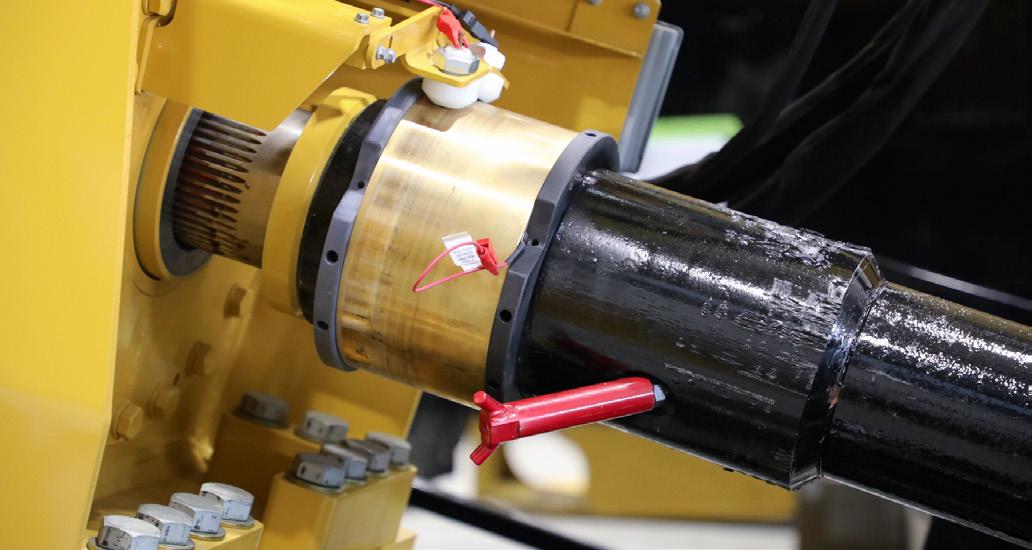
wire wheel before getting to work. That rust can contribute to prematurely eroding pads.
The water swivel on the backend of the maxi rig is under constant pressure during drilling operations. To get the maximum performance from and optimise the life of this maxi rig part, crews need to grease it approximately every eight hours of rotational operation. Grease helps to keep the internal packing glands in place to help prevent fluid leaks. There are also adjustment screws that can be repositioned if there are minor leaks, even after greasing.
Leaks are a sure sign that a water swivel is not functioning correctly. To troubleshoot the issue, begin by giving the water swivel’s grease point two pumps of grease. Crews may need to tighten the packing gland if it’s still leaking. If that doesn’t fix the issue, it may be time to replace the water swivel packing gland.
Drilling fluid leaks affect the cleanliness of a jobsite. And if a leak is left unchecked, it could lead to a major waterline blowout.
Crews should assign a person to keep an eye out for leaks in the drill fluid system and address small leaks before they become major issues later on.
Vice dies, sub savers, drill pipe threads, sliding head shafts, gearbox slides and water swivels are six of the main maxi rig parts that need regular care to help minimise more significant machine issues down the road. Following the advice outlined above and in the machine’s maintenance manual will help keep HDD maxi rig crews productive.



Michael Ray and John Minassian, Emerson, draw attention to the significant changes coming to pipeline integrity management as the previous GIS desktop environment is retired and new software becomes the standard.
he sunset on Esri’s ArcGIS Desktop environment marks the industry’s move toward both a new GIS platform and the ArcGIS Pipeline Referencing (APR) data model. It’s a significant upgrade and a substantial amount of change at all at once.
Esri will officially retire ArcGIS Desktop 10.8 in March 2026, with ArcGIS Server 10.9 retiring in December 2027. Leading into 2Q- and 2H25 will be a crucial period for pipeline companies preparing to migrate projects and workflows. The window for decision-making regarding strategies, resource allocation, and planning to stay ahead of ArcGIS deprecation recommendations is narrowing.
The ArcGIS Desktop (ArcMap) is being replaced by ArcGIS Pro. The new GIS provides the same functionality found in ArcGIS Desktop (ArcMap and ArcCatalog), with tighter integration with ArcGIS Enterprise and ArcGIS Online.
This deployment, alongside ArcGIS Enterprise, emphasises a service-oriented design with limited direct database connections. Data consumption via map and feature services enhances scalability, security, and performance. Users within a company can easily create and share content with their colleagues through ArcGIS Enterprise (Portal) or ArcGIS Online. All users can then quickly access shared
maps or dashboards from their desktop with ArcGIS Pro or with a web-browser connecting to their GIS portal.
Esri has also introduced a new information model for storing and managing pipeline data. This model is referred to as ArcGIS Pipeline Referencing, or APR for short. Esri has released the UPDM Utility Pipeline Data Model (UPDM) and worked with the Pipeline Open Data Standards (PODS) Association on the PODS 7 model –both models utilise the APR design.
The new pipeline management software, Location Referencing, is easily deployed as an add-in to ArcGIS Pro. The new Location Referencing tools allow users to manage APR databases.
Integrating components into APR presents inherent complexities such as configuring linear referencing systems or integrating legacy datasets. Implementing a PODS 7 database requires careful consideration. Testing and a phased implementation are essential for minimising downtime and smoothly navigating the transition.
System integration – including legacy systems, homegrown applications, and third-party tools – must align with the upgraded platform and new environment. Each of these steps is crucial to mitigating risks, such as data loss, operational disruptions, or compliance lapses.
The plan must address how to structure linear referencing systems as well as route-event data and workflows to meet both organisational and regulatory requirements using the pipeline company’s preferred data model and configuration.
Key decisions in GIS migration and data management
Industry-standard models like the Utility and Pipeline Data Model (UPDM) and the Pipeline Open Data Standard (PODS) are at the core of GIS upgrade and APR migration efforts. These two data models serve as the primary options when upgrading to the ArcGIS Pro + ArcGIS Enterprise environment.
Pipeline companies face two key decisions, starting with the need for a solid plan to manage the migration process and meet deadlines. First, operators must decide how their data will be stored and managed going forward. Which data model – UPDM or PODS Version 7 – best aligns with their operational requirements?
Second, they must choose between a traditional migration with a hard cutover, which is ideal for those with tight deadlines, limited IT resources, or restricted licenses – or a more gradual transition. The gradual transition allows users to implement APR in a test environment that syncs the APR database with their current production databases. This approach enables users to evaluate the new system without the need for a hard cutover.
PODS adoption of ArcGIS pipeline referencing
The PODS Association has fully embraced the new APR concept – it is the data model primarily used by most transmission operators and support providers such as Emerson. The Esri Location Referencing add-in for ArcGIS Pro seamlessly integrates with the PODS 7 data model. Users can perform route and event editing, using the Location Referencing and Event Editing tools. Because PODS 7 utilises the APR design, the Esri tools can be easily configured to work with this database.
UPDM and PODS 7 share a common logical core design, each offering enterprise geodatabase access with support for SQL Servers or Oracle. Both data models can manage transmission, gathering and distribution systems. While UPDM is structured as a proprietary model owned and managed by Esri, PODS 7 is open and community managed.
UPDM is often recommended for vertically integrated utilities with operators managing both transmission and distribution assets in a single database.
PODS 7 is focused on linearly referenced systems supporting transmission and gathering systems. It is recommended for transmission operators because it is a communitydriven, extensible data model that any PODS member can contribute to.
Because operators heavily influence PODS, new requirements can be rapidly incorporated. Multiple working groups continuously enhance the data model to address a diverse range of operational needs, from construction and cathodic protection to inspections and integrity management. Existing PODS implementations can easily migrate to the new PODS 7 platform.
Transmission operators transitioning to new GIS environments must define linear referencing systems as well as route-event data and workflows to meet both organisational and regulatory requirements. Most transmission operators already store data in a PODS data model or a similar, linearly referenced database.
Internal systems that link to pipeline GIS databases – including integrity management programs, compliance tools, and reporting systems – will all be impacted by a migration to PODS 7 or UPDM. While data in APR is linearly referenced, there are significant differences between legacy PODS models and PODS 7, and these differences can impact any point of integration.
The traditional hard cutover approach to a typical data migration is iterative, generally with only two or three migrations performed. It involves a review to identify current data sources


Subscribe online at: www.lngindustry.com/subscribe
along with documenting and mapping PODS 5.1 to PODS 7 tables and columns, including database domains.
Operators provide vendors data for the migration, in return vendors provide operators with a migrated PODS 7 or UPDM database. After careful reviews and adjustments, this process may continue several more times. Each time, the migrated data is evaluated for any mapping/loading issues. Processes can be adjusted for the next migration.
During the final migration, the operator will need to “lock” the production database from any further edits, requiring a hard cutover. After the cutover to production, the database will remain available for read-only access, but no further edits can be made.
The second migration path involves upgrading to PODS 7 from PODS Classic. This process can be facilitated with third-party tools such as Emerson’s PODS Sync Tool, which is deployed on-site at the operator’s location.
This route involves an initial full sync migration and subsequent delta sync delta migration – from PODS 5.1 to PODS 7.
Initially, a single/full migration is performed on-premises. A nightly or weekly server-based process automatically loads deltas from PODS 5.1 into the new PODS 7 database, without requiring operator intervention.
Emerson’s PODS Sync Tool automates delta migrations and logs each process, providing transparency and enabling operators to monitor progress. An optional email notification can be generated for each migration, with logs and migration status sent to specified users. All routes and events included in the current migration sync are logged.
It is important for IT and stakeholders to document all data sources being migrated, and a third-party vendor can provide valuable support during this phase. For example, Emerson will guide the company’s operators on PODS 7 (or UPDM) best practices and will also work with IT to ensure that any business rules and business practices that could affect the migration are documented.
Following the review of all data sources, data mapping of the core LRS centreline along with routes, series, and calibration points begins. During the data mapping phase, LRS core mapping in .xlsx format is delivered to the operators and deployed to the PODS Sync folder.
During the event mapping stage, Emerson will perform initial data mapping and collaborate with the operator and confirm PODS
7 tables/columns and domains. During this phase, as event table mappings are completed, new or updated mapping documents are deployed.
Once mapping is complete, Emerson’s PODS Sync Tool can run for an undetermined length of time. The tool provides a longer transition period, enabling simultaneous operation of legacy and new systems. Operators can continue to maintain PODS 5.1 production while evaluating PODS 7. This approach works toward a controlled handover and mitigates risks.
Implementing an APR data model, such as PODS 7 or UPDM, allows operators to store critical asset information in a single, integrated database. Information about the location, attributions, and condition of assets can be managed in this cohesive environment, helping to eliminate data silo issues.
An APR environment provides linear referencing tools for managing pipelines and associated components. As pipelines change through replacements or relocations, underlying assets tied to the pipeline are automatically updated. This integrated approach to managing the pipeline is essential to maintaining valid data.
The enterprise GIS with an enterprise data model, such as PODS 7, is designed to store any data relevant to pipeline assets. This includes more than just pipe information. It includes operational data, inspections, and intersections with real-world environmental data.
Linear referencing and spatial analysis play important roles by uncovering hidden relationships. Pipeline integrity management processes such as high consequence area (HCA) analysis, class analysis, and risk analysis could not occur without GIS and a linearly referenced database.
Data integration tasks can be performed faster, with less data conversion, utilising GIS with PODS 7 or UPDM. Spatial risk assessment, powered by predictive analytics and AI, enables operators to integrate enterprise data, anticipate failures, and prioritise proactive maintenance, reducing risks and costs.
GIS facilitates analysis, reporting, and data sharing across an organisation among integrity management programs, compliance, and operations teams using a unified dataset. All users can access the same data to analyse buried pipelines, assess infrastructure proximity, and evaluate population density in HCAs.
Dynamic segmentation and real-time monitoring alert operators to anomalies, for swift responses while automating data processing




• Building Canada’s infrastructure for 70 years
• Advocating for the unionized pipeline construction industry with government through labour relations, policy review, pipeline standard codes and more
• Supporting worker safety, recruitment, training and leadership development programs for members
• Fostering a Canadian-based workforce with specialized technical, trade and craft skills for pipeline construction and maintenance
for greater efficiency. Risk analysis tools can align seamlessly with the US Pipeline and Hazardous Materials Safety Administration (PHMSA)’s integrity management guidelines, integral for reporting requirements and prioritisation of asset maintenance in HCAs.
Transitioning to an APR data model, such as PODS 7 or UPDM, and upgrading the enterprise GIS platform can be complex, timeconsuming, and expensive. Operators have many questions, such as: why this is necessary? What is the best approach? How do I continue to operate my existing data management responsibilities while migrating to an entirely new system?
A well-planned approach ensures that pipeline facility data is captured, converted, and processed effectively, creating a robust data environment that supports long-term compliance and risk mitigation and integrity management. Operators can be assured that regulatory requirements will be satisfied after the migration occurs.
Even still, there are many commonly asked questions about the process, starting with “Is it really necessary?” The short answer is “Yes.” With the announcement of the ArcGIS Desktop retirement in 2026, operators need to start the process of upgrading as soon as possible to avoid challenges. Most existing data management tools were designed for the legacy GIS platform.
Which data should be moved to APR? Should inspection data be linearly referenced, incorporated into workflows for centreline editing within GIS systems, or managed in a stand-alone schema? As part of the project to migrate to PODS 7, data mapping exercises will identify the source and the destination for all datasets. This includes inspection data, such as ILI and direct assessment. The flexibility of the enterprise database will facilitate the process by enabling operators to choose how and where to store data to best align with their operations and workflows.
Taking a holistic approach
Companies can further streamline data management by deploying an add-in to ArcGIS Pro. Emerson’s IntegrityManager™ Software Suite provides a complete solution that can be deployed as a single ribbon/add-in. It is also data agnostic, supporting APR models such as PODS 7 and UPDM, but can also work with any database that utilises linear referencing to store data.
Legacy solutions were deployed outside of ArcGIS – with limited GIS functionality. Emerson’s solution will deploy within ArcGIS Pro, allowing the user to exploit complete GIS functionality and leverage its full capabilities. Operators can move into this new GIS platform with assurances that their integrity management needs will be covered.
A complete integrity management program has multiple aspects, including HCA, MCA, and class analysis, data integration and risk analysis, integrity assessment planning and data loading, and reporting. Emerson’s software suite extends existing APR databases which allows analysis and results to be stored in a company’s enterprise database.
A web-based reporting and dashboard system provides more complex calculation and reporting tools. For example, the software can design and generate alignment sheets and manage protocols for PHMSA and US National Pipeline Mapping System (NPMS) reporting.
Most users need view-only access to GIS, and through the ArcGIS Portal (web maps, dashboards, web experiences), most of their needs will be met. Field users performing repairs, inspections, or patrols use Esri Field Maps on mobile devices.
The advanced GIS and APR model empower operators with spatially driven insights to enhance safety, efficiency, and collaboration. Companies will take a significant step forward in modernising pipeline workflows, improving risk assessment, and building a stronger foundation for integrity management by migrating.
ArcGIS 10.8.2, the final ArcMap release, will be supported under its product lifecycle until 1 March 2026. ArcGIS Pro 3.x is fully compatible with Enterprise 10.9.1, which is designated as a longterm support release. Compatibility with ArcGIS Pro versions and APR models will be maintained to facilitate a seamless integration.
The retirement of ArcMap and the eventual retirement of ArcGIS Server 10.9.1 require operators to look at upgrading their enterprise GIS and enterprise database. This upgrade to the new GIS platform will most likely result in a positive change, as the software can make it easier than ever to organise and share information with your organisation. The new APR design is now the standard in all pipeline data models, and it covers both PODS 7 and UPDM. Because this design is becoming ubiquitous, it improves data interoperability between vendor solutions. The new data model is also designed to be spatial by nature, meaning data is stored with its spatial location as part of the record.

Change can be disruptive, and this upgrade is not trivial. It requires an upgrade of the enterprise GIS, the enterprise database, and solutions that support your integrity management program. However, the benefits are significant and will enable operators to fully leverage data like never before.





Elizabeth Corner speaks to the two winners of the PPIM 2025 YPI Award for Young Achievement: Zachary Booth (DNV) and Kaushal Shah (ICF).
Zachary Booth, Senior Engineer, DNV
Elizabeth Corner: Congratulations, Zach! What are your thoughts upon winning the award?
Zachary Booth: I am honoured to receive, and to be considered among the other influential industry leaders who have also received this award. I consider this a significant highlight of my career.
EC: Can you describe your current job role in one sentence?
ZB: I am a senior pipeline integrity engineer working to help pipeline operators ensure they are operating their assets safely and considering industry best practices.
EC: What does a typical day in your role look like?
ZB: Every day is pretty different, but a typical day can range from providing assistance with dig programmes, to working towards
solutions in research projects. At the end of the day though, my job is to understand the needs and challenges of clients and find suitable and practical solutions that prioritise the safety of human life and protection of the environment.
EC: Did you always want to work in the pipeline industry?
ZB: Actually no! I was in college and I was applying to jobs, and I got an interview at DNV. After meeting the team I would be working with, I felt like this would be an environment where I could fit in and thrive.
EC: What has been your career highlight so far?
ZB: I have the opportunity to lead several collaborative industry projects dedicated towards the improvement of inline inspection technology and in-the-ditch material property measurements. Through these projects, I have been able to work with many

senior leaders and refine both my project management and technical skills.
EC: Can you tell me something I might not know about DNV?
ZB: We are based in Norway and we have a lot of different business areas. Many people, especially in the US, are familiar with our work in the pipeline industry, but our energy group has other focus areas as well, including renewables and emerging fuels. We have a significant focus towards digitalisation and AI. Lastly, we are also known for our of work in maritime industry and our certification work. So it’s a very broad company that has its hands in a lot of different areas.


EC: Do you have any mentors or role models in the pipeline industry?
ZB: Dr. Thomas Bubenik has been a fantastic mentor of mine. I have had the privilege to work closely with him on several projects and his unique ability to critically evaluate my work and provide positive reinforcement has had a significant impact on my professional development.
EC: What do you think is great about working in the pipeline industry?
ZB: I think being a younger engineer, the industry is very willing –once you show that you can be reliable – to keep investing in you, put you in leadership positions, and take you seriously. I work with a lot of people who are much smarter than me, but they’re willing to invest in me and help me develop. The industry understands the value in working with young professionals and knows that we need to be able to rely on our current workforce of young professionals in 10, 20, or 30 years.
EC: And that’s the important work that the YPI is doing, of course. What is your involvement in YPI? How long have you been a member?
ZB: I’ve been a member for six years now and my role has changed a lot in those years. I started off helping to plan webinars and smaller events, I was the Treasurer for two years, and last year I planned our flagship event, the YPP Symposium. Our keynote speaker was Stan Chapman, the COO of TC Energy. It was a really challenging event to plan, but it was really rewarding too.
EC: What makes this industry rewarding and attractive for young professionals?
ZB: This industry has so many opportunities and is constantly searching for young talent to take responsibility to ensure a safe future for us all. If you become someone people can count on, senior leaders will not hesitate to acknowledge you and find ways for you to make a difference.
EC: What are your hopes for the future?
ZB: As I get older, I have started to realise that there is only so much value I can bring to my company and the broader industry as an individual. My hope is that by investing more time into developing younger talent, I can help make a larger, more meaningful impact on our industry’s future.
Kaushal Shah, P.E., PMP, MBA, Senior Project Manager, ICF
Elizabeth Corner: Many congratulations, Kaushal! How do you feel about winning the award?
Kaushal Shah: I am both thrilled and deeply humbled to be named one of the recipients of the 2025 YPI John Tiratsoo Award for Young Achievement. This honour represents far more than a personal milestone – it’s a reflection of the outstanding support, mentorship, and encouragement I’ve received throughout my journey in the pipeline industry.
I want to extend my gratitude to PPIM for recognising my contributions, as well as to Young Pipeline Professionals USA (YPP USA) for providing me with countless opportunities to grow and learn. I owe a special thanks to my family, particularly my father,
Vinod Shah, whose unwavering belief in me has been the bedrock of my success. My mentors and friends have also played a vital role in fostering my passion for this field, and I am incredibly thankful for their guidance.
It’s an exciting time to be involved in shaping the future of the pipeline industry, and I look forward to continuing my work alongside such dedicated professionals. I also want to express my appreciation to Lauren Tipton for nominating me, and extend congratulations to my fellow award recipient, Zach Booth.
EC: Can you describe your current job role in one sentence?
KS: I am a Senior Project Manager in ICF’s Consulting Technical Advisory Practice, where I provide independent engineering and owner’s advisory technical due diligence for integrated energy companies and financing entities.
EC: What has been your career highlight so far?
KS: My career highlight has been my involvement with YPP USA. Since joining as a Community of Practice workgroup member in 2016, I’ve steadily taken on greater responsibility, becoming a workgroup lead in 2018, an officer in 2019, Vice Chair in 2021, and ultimately Chair in 2023. This progression has allowed me to create meaningful opportunities for the next generation of pipeline professionals.
Under my leadership, YPP USA membership has grown from 350 to over 950 members. I’ve spearheaded initiatives such as the BRIDGE workshop, which unites industry experts with emerging
professionals to exchange knowledge and insights. I’ve also expanded YPP USA’s leadership structure to broaden our impact and established essential programmes – mentorship, diversity and inclusion, and corporate support – that now serve as cornerstone workgroups, annually benefiting more than 300 members. I’ve also organised and led multiple YPP USA symposiums, which bring together over 250 members annually to share advancements in the industry and highlight success stories of leaders.
EC: Did you always want to work in the pipeline industry? What do you like about the sector?
KS: The pipeline industry is just such a welcoming place to grow a career. Growing up internationally, I’ve always understood the role for pipelines, so I picked my first job intentionally to be in the industry. I like the duty of care we show. I work with someone in at ICF who is in his early 70s and, when I worked at my old employer, I refurbished a pipeline project that he had built. I went back and checked the drawings and his initials are on it. I never knew what those initials stood for, but now I do. He did a great job back then; his initials are there, and four lines later, my initials are now there.
EC: What motivates you to go to work each day?
KS: I think for me is a lot of it is community, I’m a very community based person. What motivates me is that I know that any work product I do, I want to make sure it reflects the best effort that me and my team can put forward.




EC: Do you have any mentors or role models in the pipeline industry?
KS: I have a few! Vinod Shah, an engineer with over 40 years of experience in the oil and gas industry, and the Managing Director of Muscat Engineering Company headquartered in Muscat, Oman. Paul Amato, the Senior Vice President Operations at Iroquois, and my mentor in the INGAA Foundation mentorship programme. Susan Waller at Natural Allies, and previously Enbridge’s Vice President of Stakeholder Engagement and enterprise-wide public awareness programmes. Brian Wolf, the Energy Unit General Manager since 2018 of Mott MacDonald. Mike Tomadakis, Founder of Stitch Humanity. And Mark Penshorn, Fuels Group Manager at ICF.
EC: What is your message to other young pipeline professionals?
KS: The pipeline industry offers a unique blend of technical challenge, tangible impact, and community engagement that makes it incredibly rewarding for young professionals. Whether you’re designing new infrastructure, applying innovative technologies, or ensuring environmental and operational integrity, every project has a direct effect on energy access and safety for communities around the nation and the world.
One of the most attractive aspects of this industry is the tremendous support system and collaborative spirit. Through organisations like Young Pipeline Professionals USA, you can gain access to mentorship opportunities, leadership development, and hands-on learning experiences that accelerate both your professional and personal growth. You’ll also become part of a close-knit network of peers, mentors, and industry experts who are passionate about fostering the next generation of pipeline leaders.
Finally, the industry is evolving rapidly to meet today’s complex energy demands, making now an especially exciting time to get involved. As young professionals, we have a chance to shape the future of pipeline technology, sustainability, and global energy infrastructure. Embrace every opportunity, challenge yourself to learn, and stay curious. Together, we can drive innovation forward and leave a lasting, positive mark on the world’s energy landscape.
EC: What are your hopes for the future?
KS: My hope is that we will build a resilient, future-forward pipeline network capable of meeting both US and global energy demands – encompassing everything from traditional oil and natural gas to emerging energy sources. By doing so, we can bolster economies around the world while meaningfully contributing to the decarbonisation effort. This is a rare moment in history where technology, data analytics, and artificial intelligence can enhance the reliability and safety of our infrastructure while lowering our carbon footprint.
Beyond the technical aspects, it is equally important that we cultivate a talented, forward-thinking workforce: young professionals who are passionate about shaping a cleaner, more equitable energy future. By investing in our people and applying the latest advancements, I believe we can transform the pipeline sector into a
of sustainable energy development that benefits
and future generations and transfer the duty of care for our industry.



In this episode, Elizabeth Corner speaks to Beth Worrell, Managing Director and Chief Legal Counsel of the Pipe Line Contractors Association (PLCA), about how the PLCA represents the union contractors that build and maintain the USA’s energy infrastructure.
This episode of the podcast covers:
• An overview of the PLCA’s mission and how it serves the pipeline construction industry in the USA.
• What types of companies and professionals typically join the PLCA.
• How the PLCA supports the professional development of its members through training and skills programmes.
• How the organisation fosters a sense of community and connection among members.
• How the PLCA foresees the future of pipeline careers.
• And more!


Elizabeth Corner speaks to Kevin O’Donnell, Executive Director of the PLCAC, about how membership organisations benefit the pipeline sector and those who work in it, discussing events, networking, resources, training, skills development, and learning.












Considering that it takes pigs to move unwanted liquids through the pipeline to the slug catcher, pigging and liquids management have always gone hand-in-hand — even though pig launchers and slug catchers are usually miles apart.
The problem with this physical divide is that it’s easy to think one piece of equipment doesn’t have much to do with the other. This couldn’t be further from the truth.
By integrating its SureLaunch® Multi-Pig Launching System and harp-style slug catcher, WeldFit optimizes pipeline pigging and liquids handling for more control over risk, equipment costs, safety, and emission— bringing you closer to your operational and financial goals. That‘s TOTAL INTEGRATION For more information, contact your WeldFit representative.

